There’s no doubt about it – artificial intelligence (AI) has revolutionized the content creation industry. Using AI writing tools allows you to create content faster, research topics in a matter of seconds, and enhance the overall quality of your output. However, AI-generated content isn’t always up to par. It might sound monotone, include inaccurate information, and lack nuance.
That’s why numerous organizations, individuals, and even search engines aren’t particularly fond of AI-generated content. They insist on human writers to ensure authenticity, accuracy, and emotional depth. This is why search engines, websites, blog platforms, etc, are using advanced tools with evolving algorithms to detect and identify AI-generated content.
So, is that it? You can’t use AI to streamline your writing process? Well, not quite. There are ways to make ChatGPT-generated text undetectable and present AI-written content as humans. We are going to show you how to make the changes, and test the listed methods to see if they are actually effective.
10 Ways to Make AI Content Bypass AI Detection
For an ambitious writer, AI content detector tools can be quite a hurdle. But you can learn how to bypass AI detection tools, and what was once a hurdle will become a stepping stone to more efficient content creation. With the techniques outlined below, you should be able to outsmart AI detection free of charge!
Consider Using Professional AI Bypassers
Let’s start with the most drastic approach. If some open AI checker keeps giving you a hard time, it might be best to simply rewrite your content. Now, doing this manually defeats the whole purpose of using AI to aid your writing. That’s why you need one of the best undetectable AI writing tools: HIX Bypass.
Try HIX Bypass to Create Undetectable AI Writing
HIX Bypass can help you bypass some of the most popular AI detectors on the market, including widely used tools like GPTZero and Originality.ai. HIX Bypass works by rewriting your content, and “humanizing” it in the process. This makes your output 100% undetectable to AI checkers.
HIX Bypass Can Outsmart Them All
But don’t let the word “rewrite” scare you. Your content will still maintain its original meaning. It just won’t contain any of the characteristics that trigger AI detection.
If, however, you want to slightly tweak your original style, you can use HIX Bypass to adjust the bypass mode to better suit the purpose of your content. For instance, you can set the bypass mode to “Fast” for a slight rewrite, or “Creative” for more significant changes in order to bypass more AI detectors.
To see if it actually works, let’s put HIX Bypass in a real-life test and see if it can truly make AI-generated undetectable and bypass their listed AI detectors.
First, we head over to ChatGPT and ask it to generate a short article about the relationship between geographical locations and correlated cultural differences.
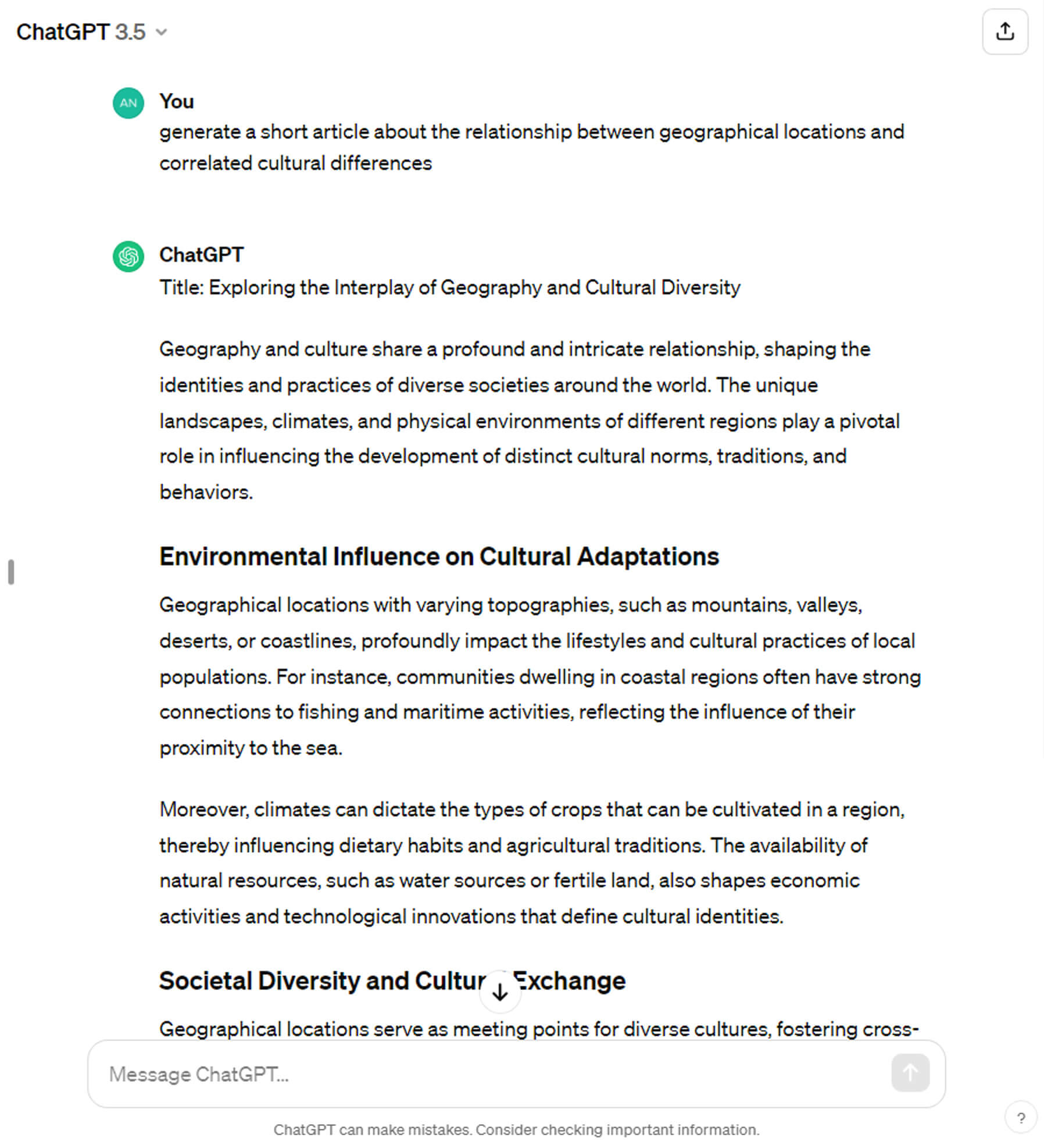
Then, we are going to put the generated content into HIX Bypass to humanize the AI text, and this is what we are getting.
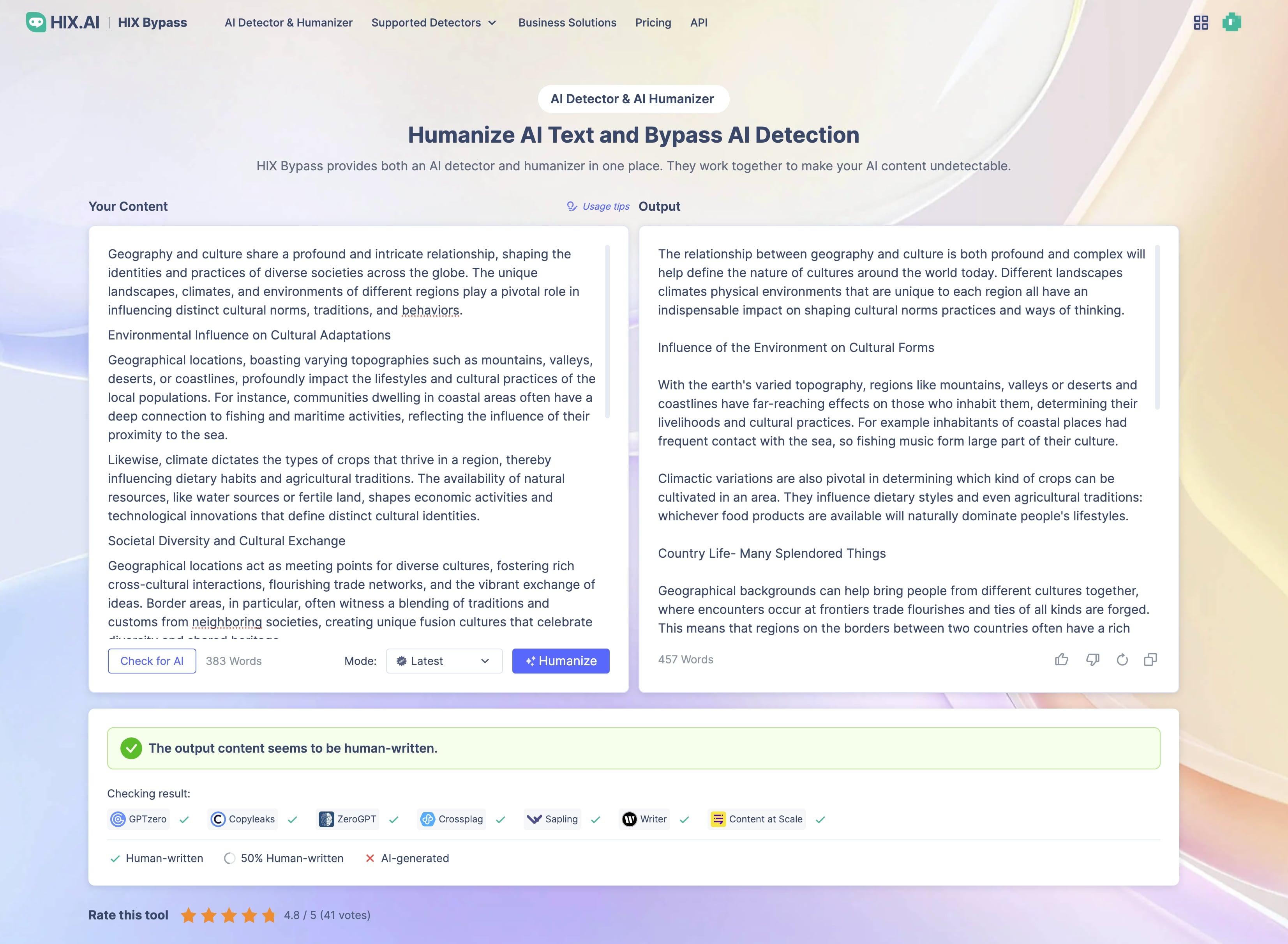
Note that there is a built-in AI content checker feature right under the output box, meaning that you will no longer need to visit other AI detector sites in order to check the AI score of the humanized content. Some of the major AI detection tools are included as well, such as GPTZero and Originality.ai.
Still, in order to keep the test even more accurate, we are going to put the humanized content into Originality.ai, GPTZero, and Content at Scale. Here are the results we are getting.
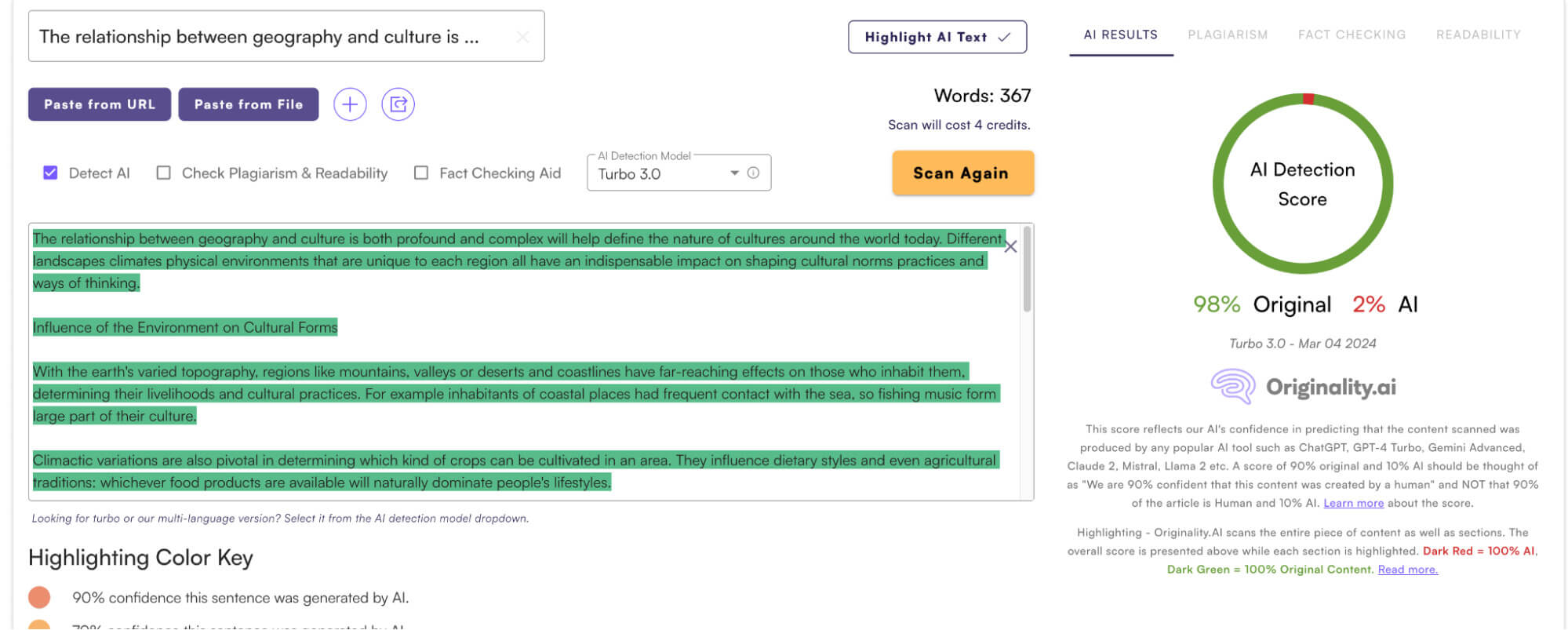
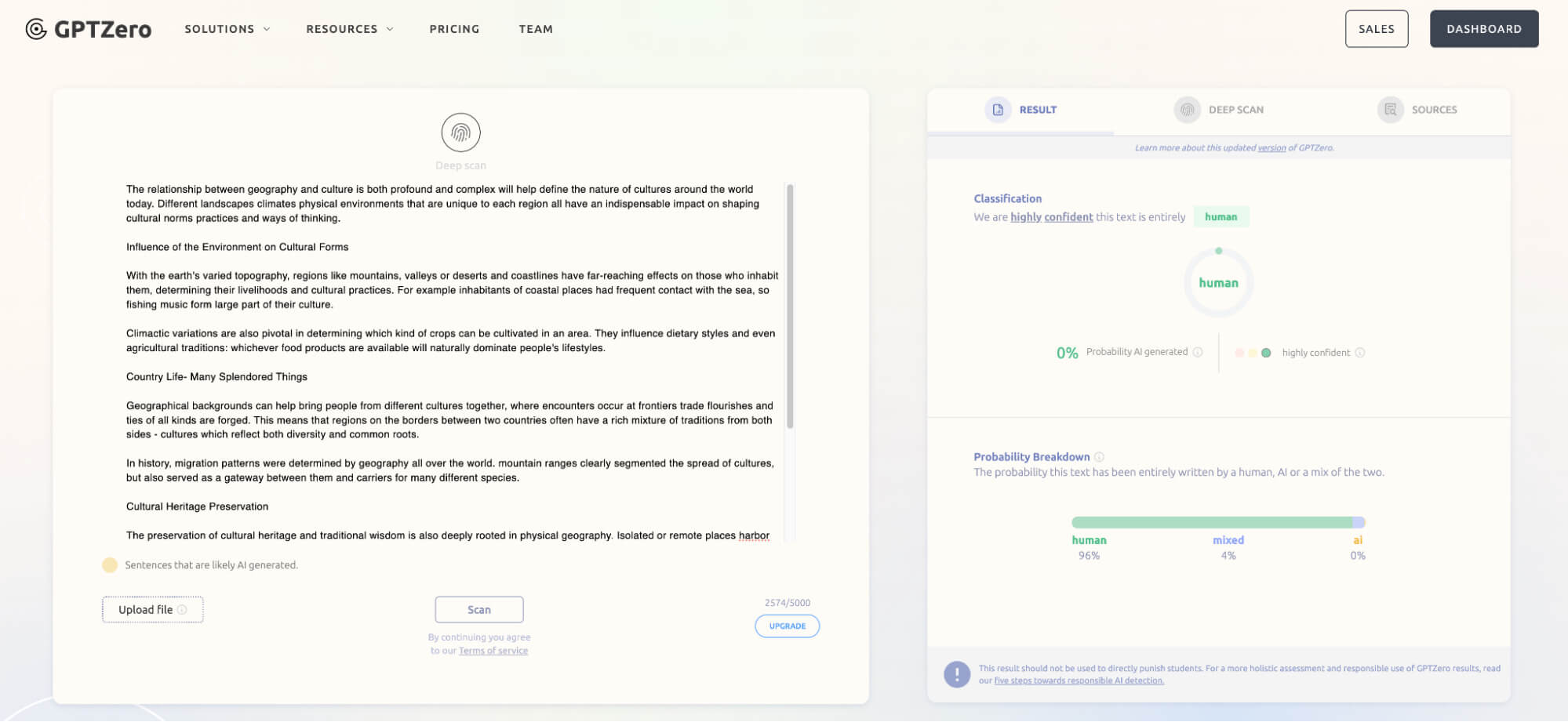
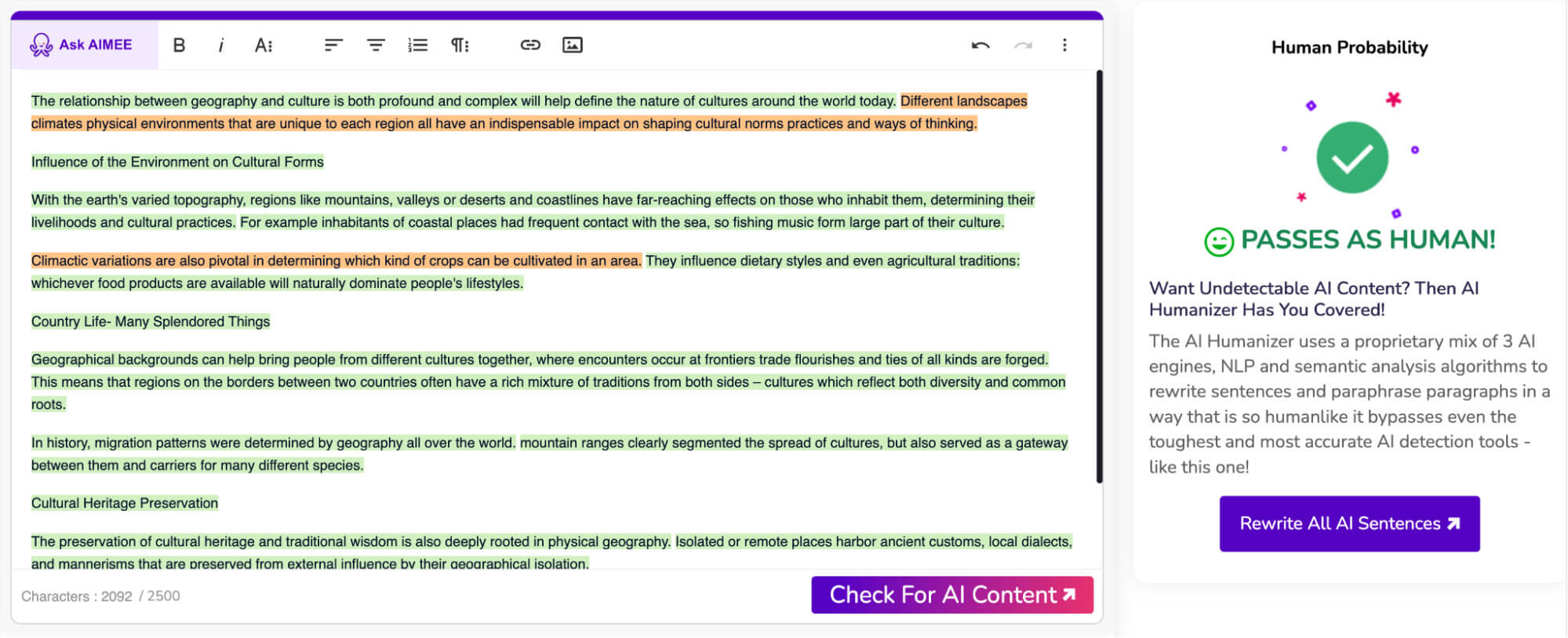
The results are impressive. The content processed by HIX Bypass is getting an outstanding 98% original score from Originality.ai and is having no problem at all when bypassing GPTZero and Content at Scale.
Mix Up the Sentence Structure
Sentences of the same length and structure are a hallmark of AI writing. If all of your sentences start the same (e.g., with the subject), detectors will likely flag them as AI. So, shorten or lengthen the AI-written sentences, play with their structures, and infuse variability wherever possible.
For instance, in the AI-generated text, sentences predominantly begin with the subject. In order to change that, we've introduced variety by starting with prepositional phrases, using passive constructions, and varying sentence lengths. This is how the modified version looks like.

And, we are going to test if this method can actually work.

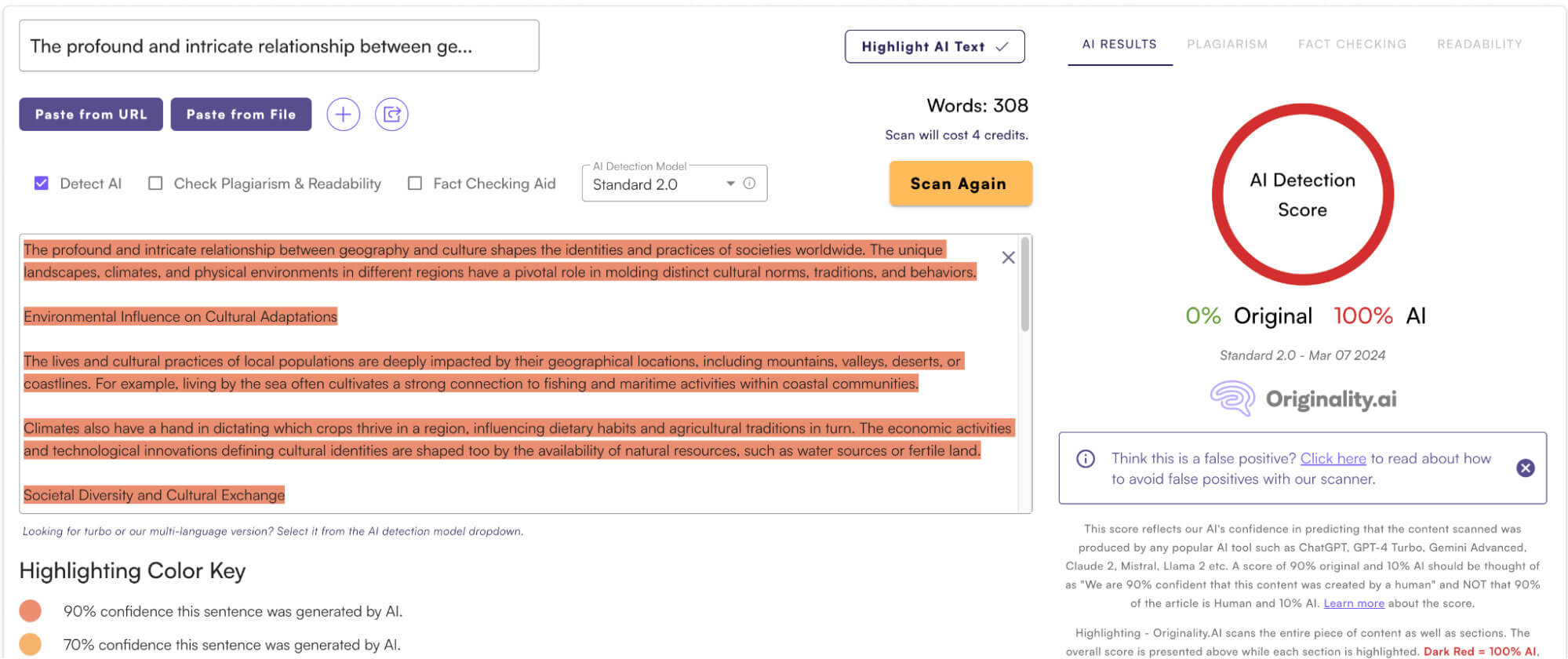

From the test results, this method is kind of working for Content at Scale (more content is marked green), but it still considers the content AI-generated. Not to mention the rest of the two AI detectors, which both of them still consider the modified version as AI-generated.
Increase Diversity
Diversity doesn’t only matter for sentence structure. It’s also instrumental to your content’s vocabulary and grammar. If you’ve used AI writers for a while now, you’ll notice they overuse specific expressions and structures. Your goal is to eliminate these from the final content piece. Even if you don’t spot any of these, mixing up the grammar structures and inserting synonyms can help keep your content less susceptible to AI detection.
We have made several changes to enhance the diversity of expression, avoiding overreliance on certain phrases and structures that can detract from the originality and richness of content. Our goal here is to present content that feels authentic and less prone to AI detection. Let’s see if this method works.
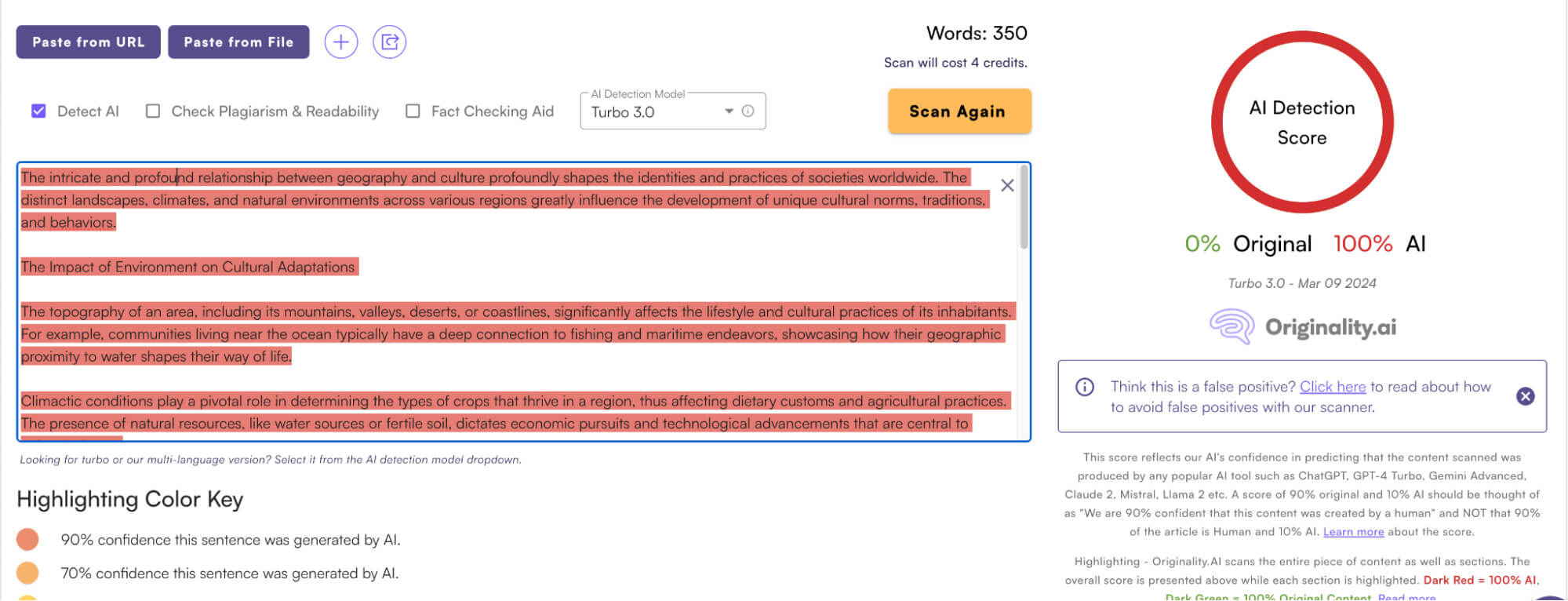
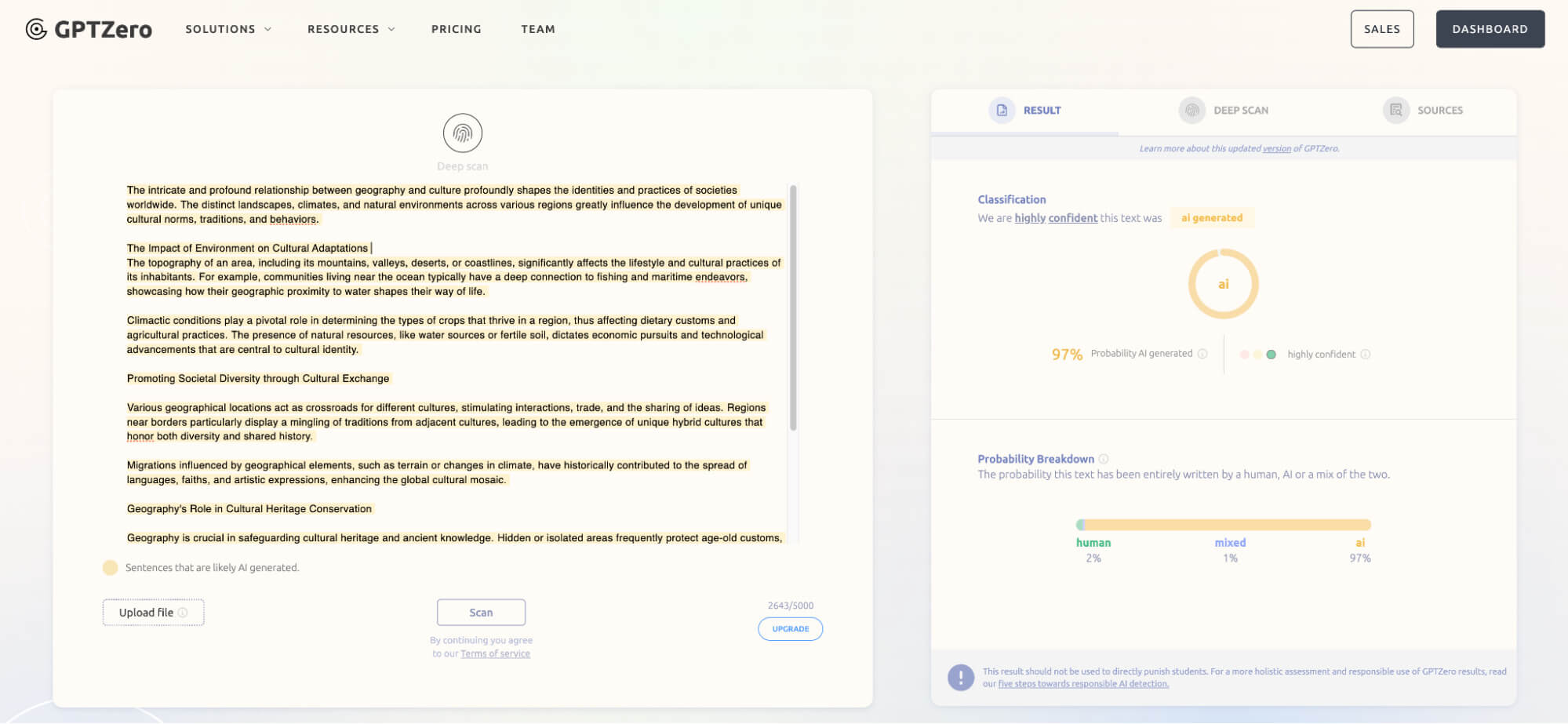
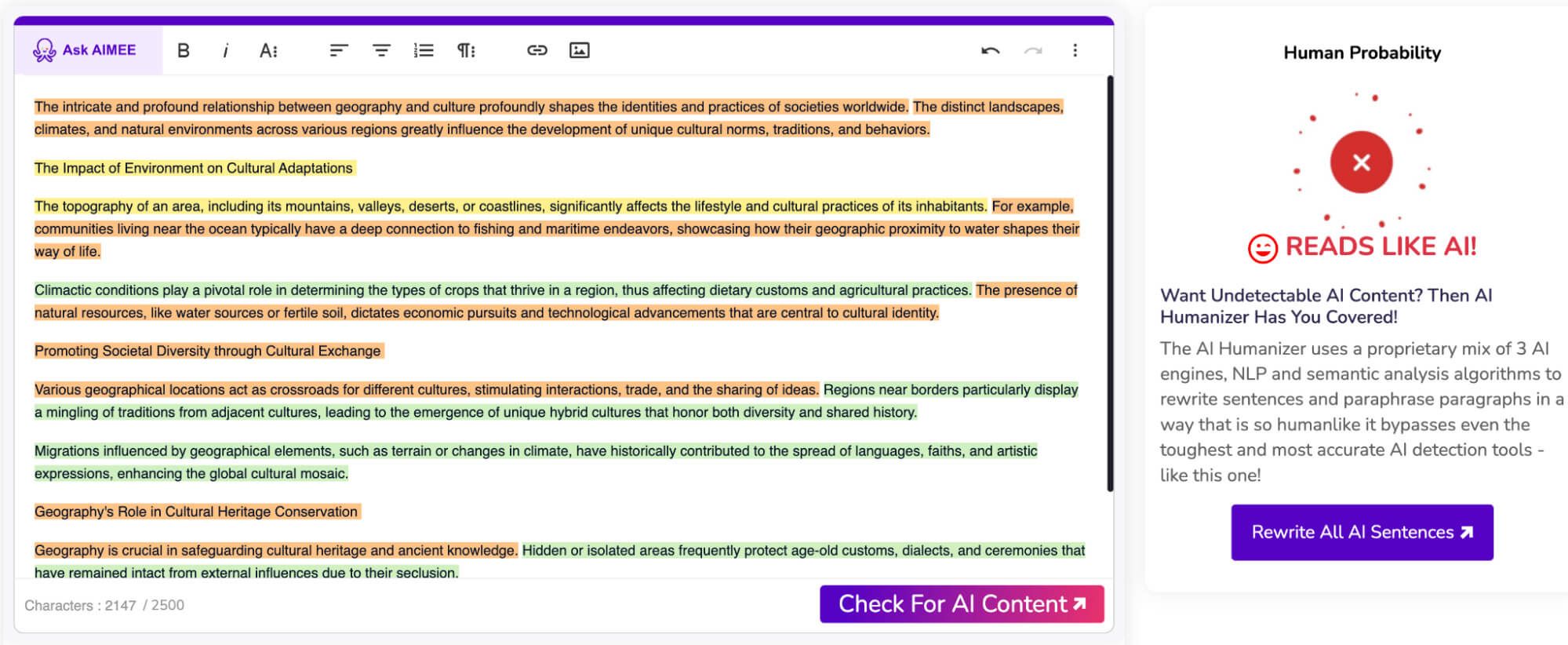
anges are not “smart” enough to bypass the listed AI detectors. Although there are some green marks in the scan result from Content at Scale, the content is still considered AI-generated.
Insert Keywords
Keyword stuffing is a big no-no in the world of SEO. However, organically integrating keywords into your content can help it rank higher with the search engines. Best of all? This can also help you trick AI detectors, as organically optimized texts tend to set off fewer alarms.
In our revised version, we added some keywords such as "geography and culture", "cultural adaptations", and "preservation of cultural heritage" within the context of how environmental factors shape societal norms and practices. Let’s see if this measure can actually work.
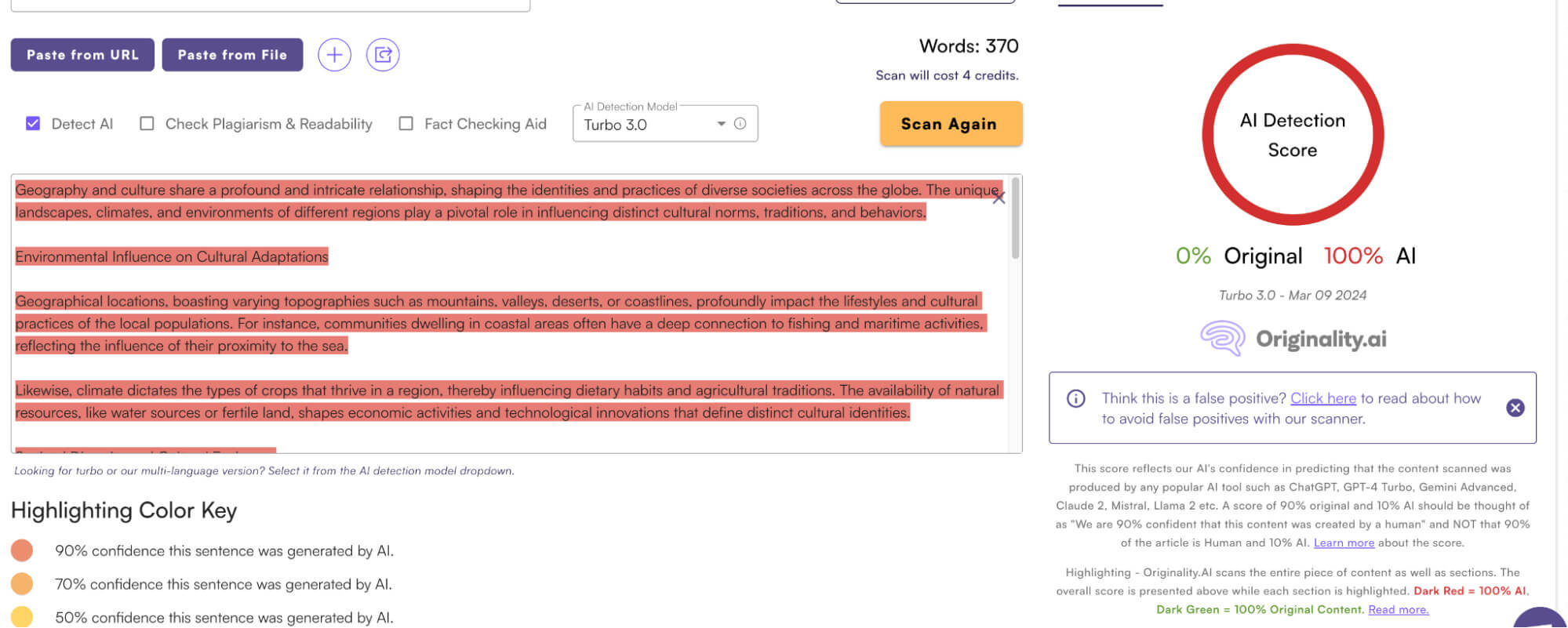
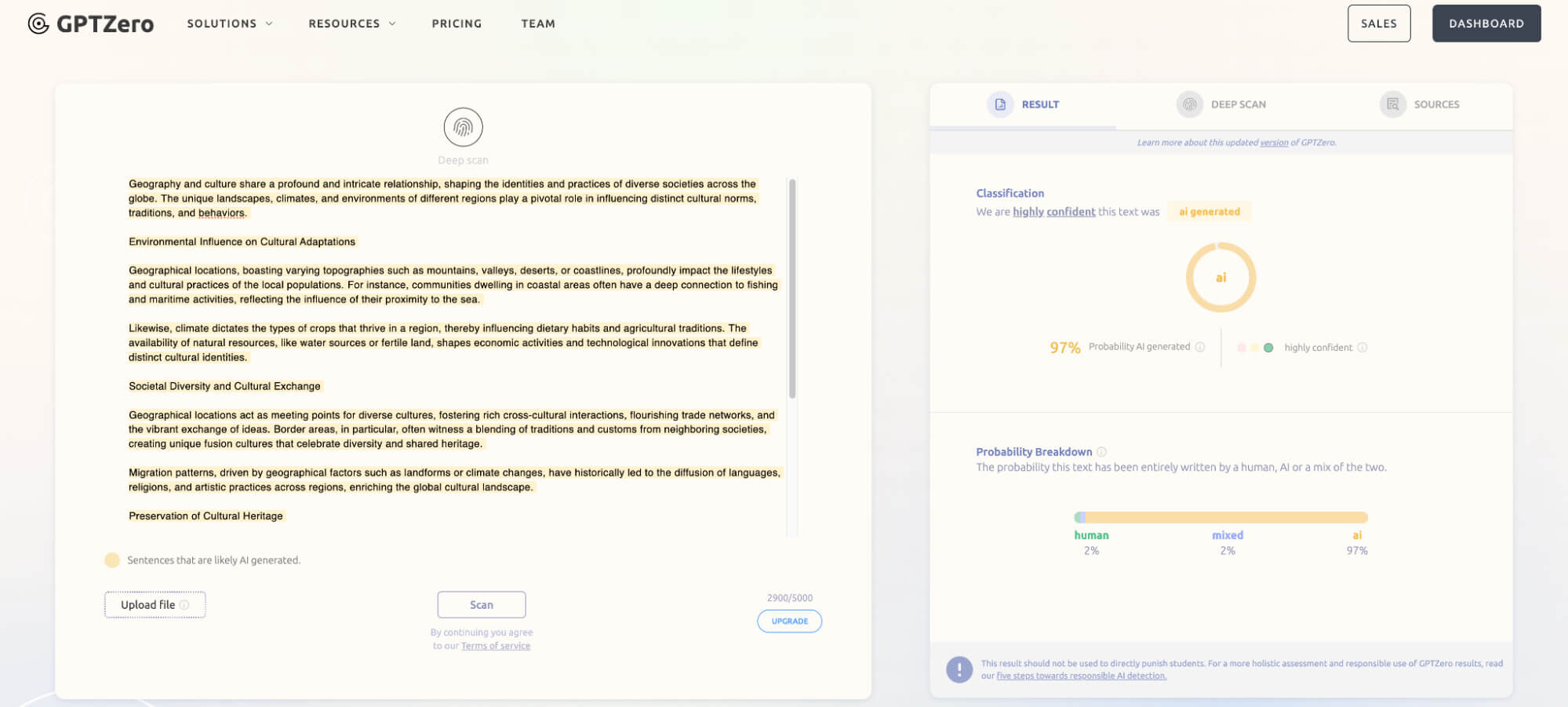
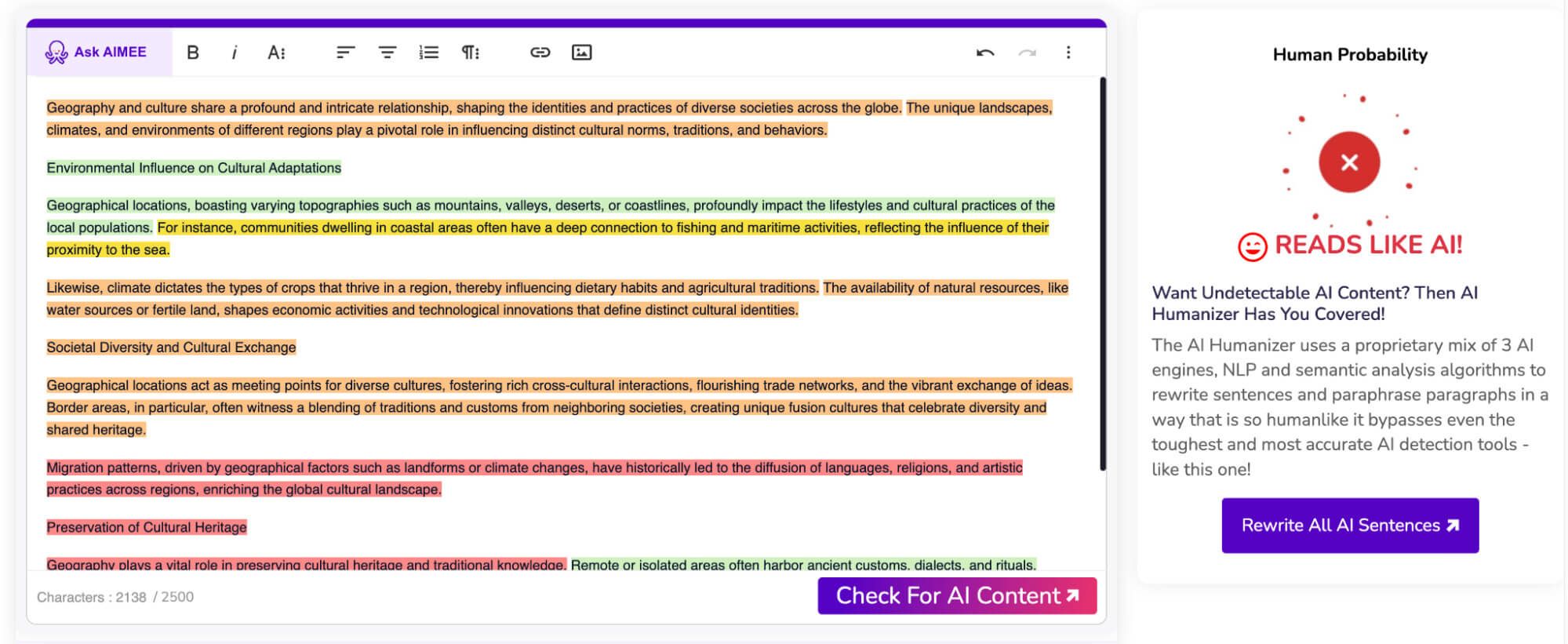
Unfortunately, simply adding keywords did not make any difference in terms of the AI-writing score. All three AI detectors consider the processed content as AI-generated. It’s better to combine this method with other strategies to ensure more comprehensive AI text humanization and SEO optimization.
Insert Contextual Collocations
AI-crafted texts can often contain phrases that are grammatically correct but simply don’t work well contextually. So, inspect your AI-written output for any of these awkward phrases and make the necessary changes. Inserting collocations (words that naturally go together) can reduce the odds of your content being flagged for AI.
We have made several changes to enhance readability and contextual relevance. Our goal is to eliminate phrases that, while grammatically sound, were contextually awkward. Incorporating appropriate collocations, such as "deep-seated maritime culture" and "agricultural blueprint," may reduce the chances of the content being recognized as AI-generated, ensuring a more natural and engaging read.
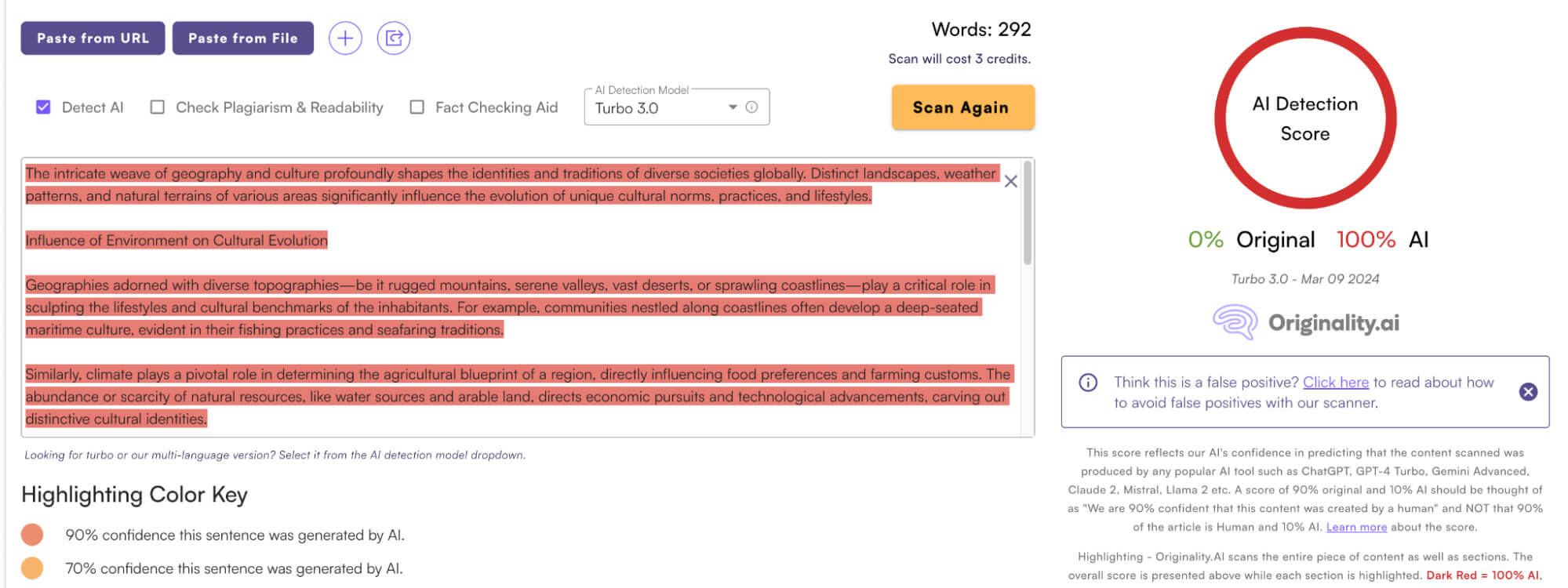
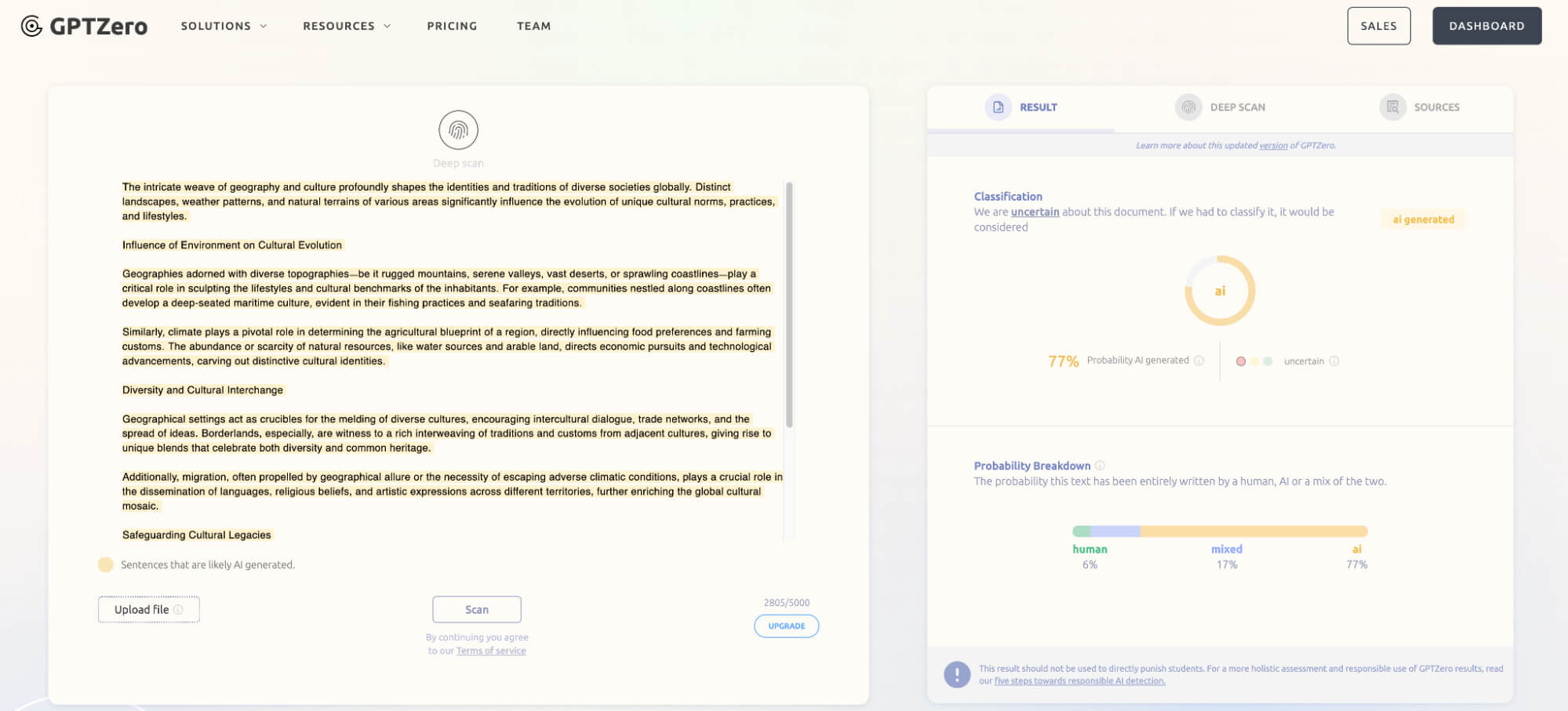
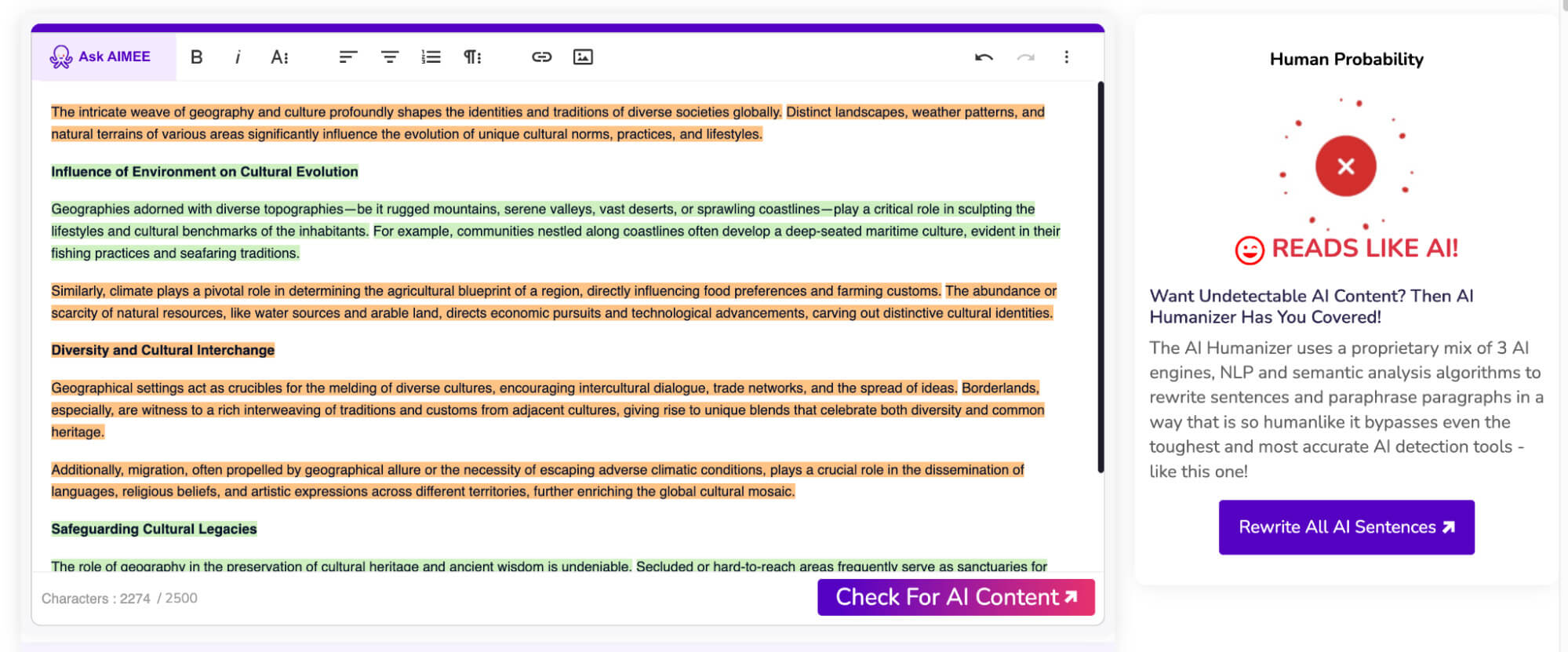
The results indicate that this method actually worked for GPTZero and Content at Scale, in which the adjustments had successfully reduced the AI score of the target content (less content marked red by Content at Scale). However, Originality still considers the content as AI-generated content.
Be Ultra-Specific
Unless instructed otherwise, AI-writing tools tend to write pretty general and vague content. They’ll rarely give examples and specific details seen in human writing. So, to avoid AI content detection, read through the text and insert relevant details that enhance its authenticity. Adding a personal story can also further humanize the content, making it virtually undetectable.
We've made several changes to infuse the article with specificity and authenticity, mirroring the rich tapestry of human experiences. For instance, we mentioned the Inuit's survival skills and the fusion cuisine of Ciudad Juárez and El Paso, trying to provide vivid illustrations that bring abstract concepts to life, so as to enhance reader engagement and understanding.
Here is the revised version of the article:
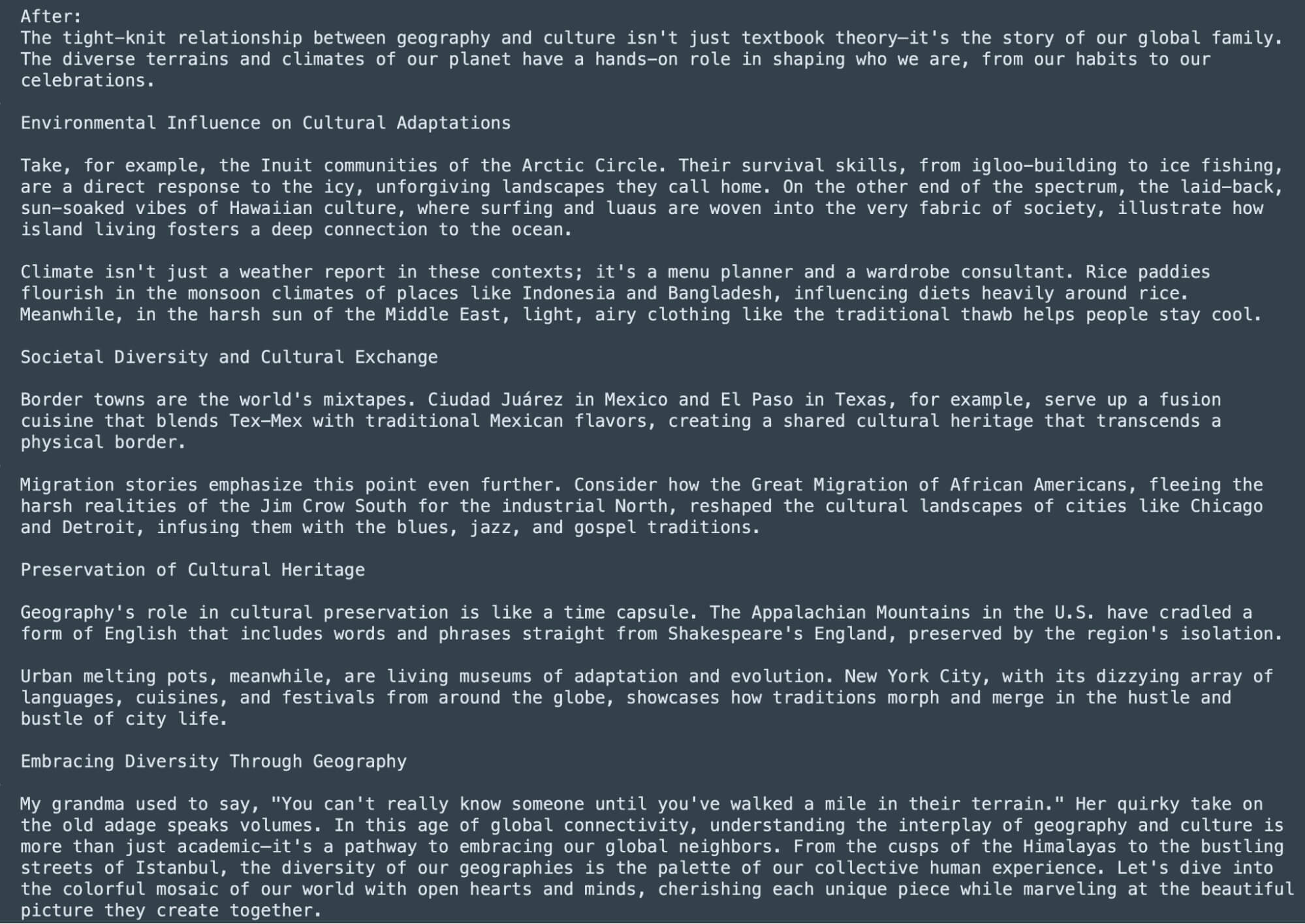
And let’s see the results from the listed AI detectors.
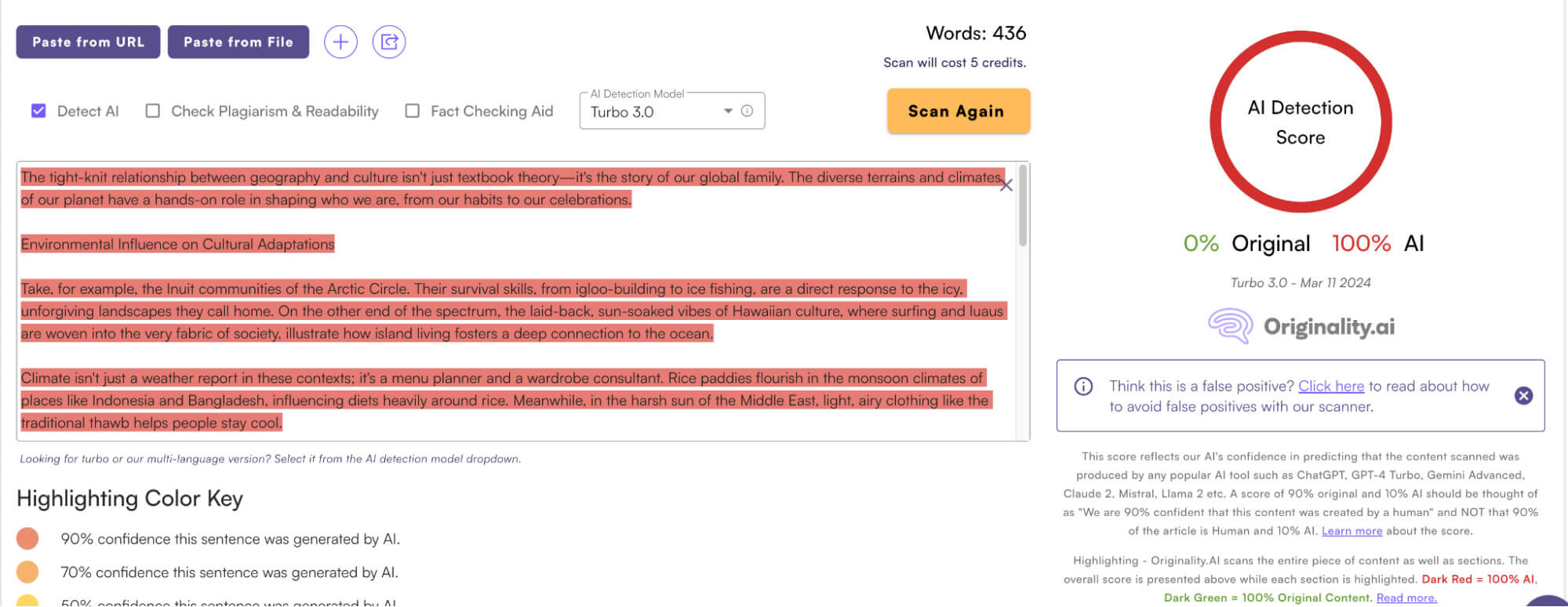

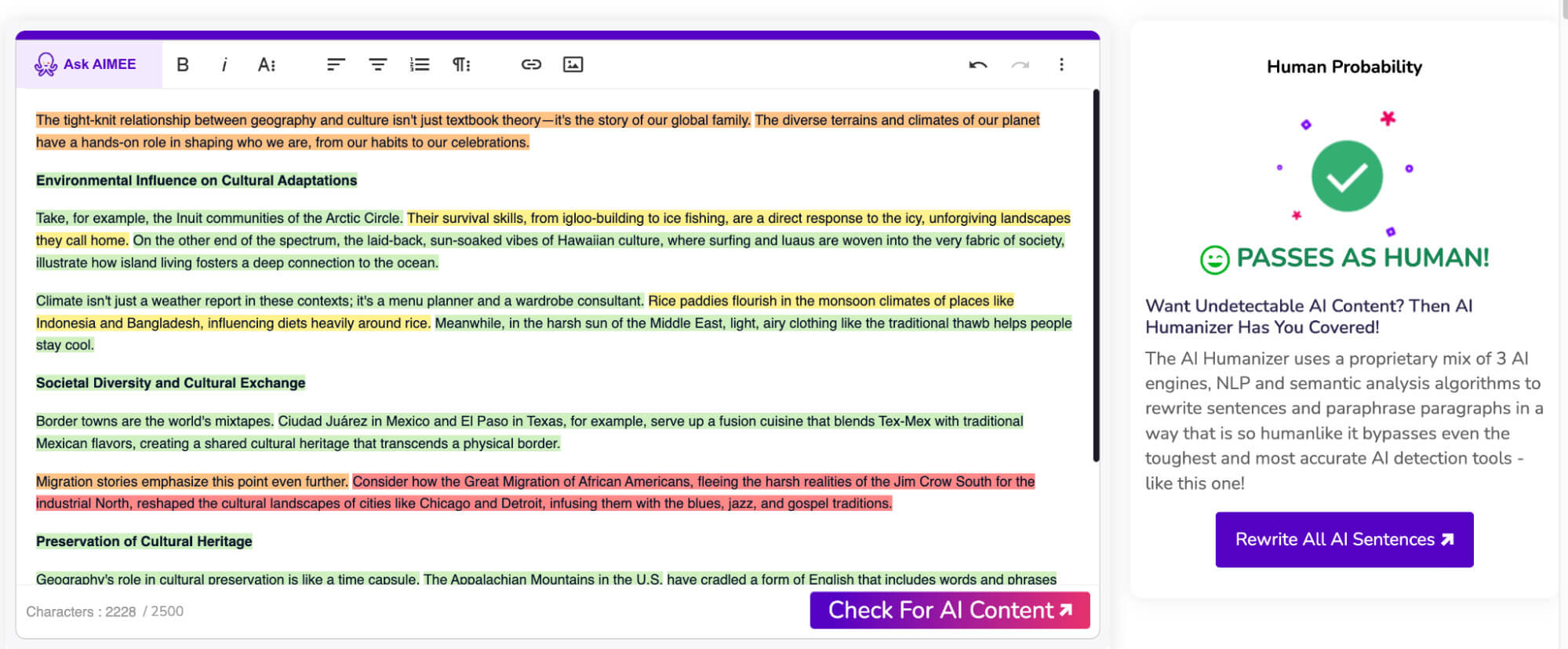
Seems like the trick did work for GPTZero and Content at Scale, in which the 2 detectors both considered the content had a large possibility of being written by a human. However, this level of modification can not bypass Originality.ai’s detection. Thus, if you are looking to bypass Originality, you may need to consider further text humanizations.
Incorporate Distinctively Human Elements
When humanizing AI-written content, don’t stop at adding personal stories. Insert anything distinctively human that fits the context, like colloquialisms or humor. As advanced as AI writing tools are, they can’t replicate these nuanced elements of human writing that make it so relatable and engaging.
This time, we have made several adjustments to incorporate distinctively human elements. Beyond adding personal narratives into the text, we introduce colloquial phrases, subtle humor, and the occasional idiosyncrasy—a sparkle uniquely human. We hope these layers of richness can transform a piece of AI-like text into a relatable, engaging conversation.
This is the final result:

Let’s see if it works.
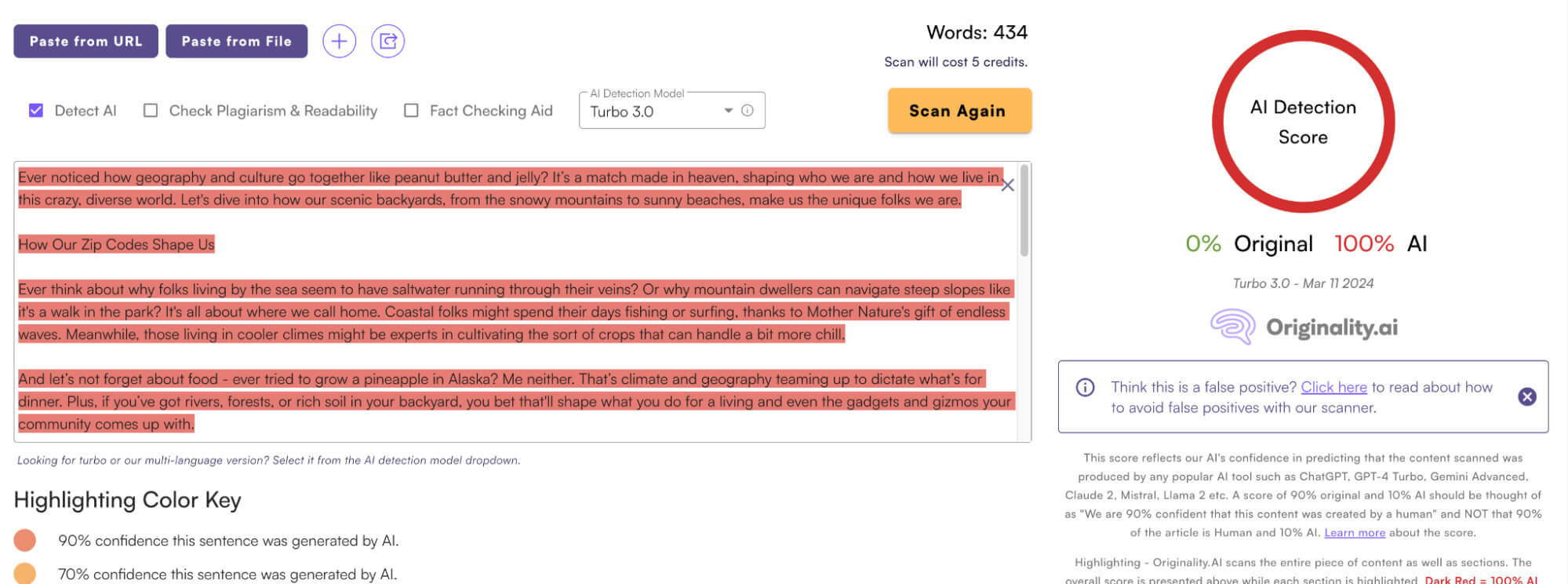
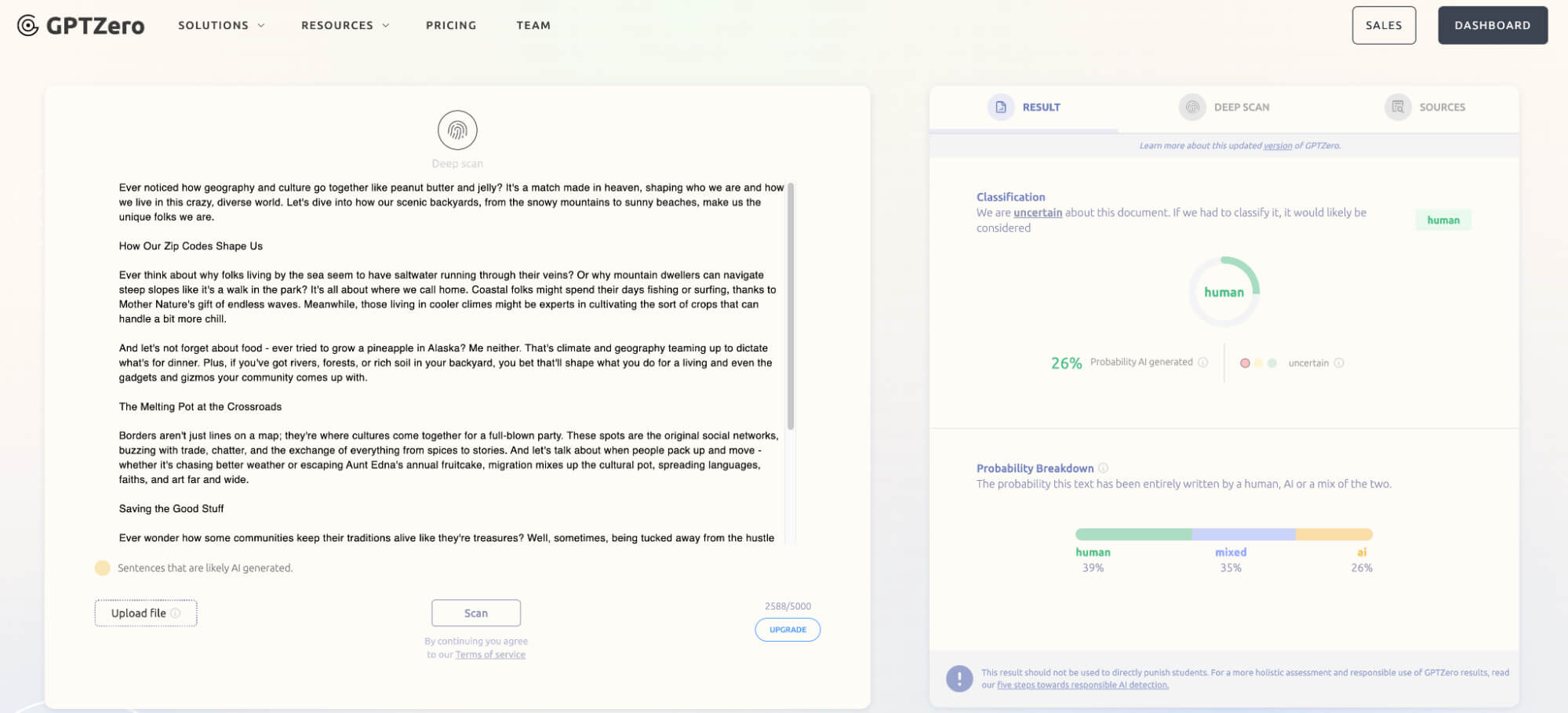
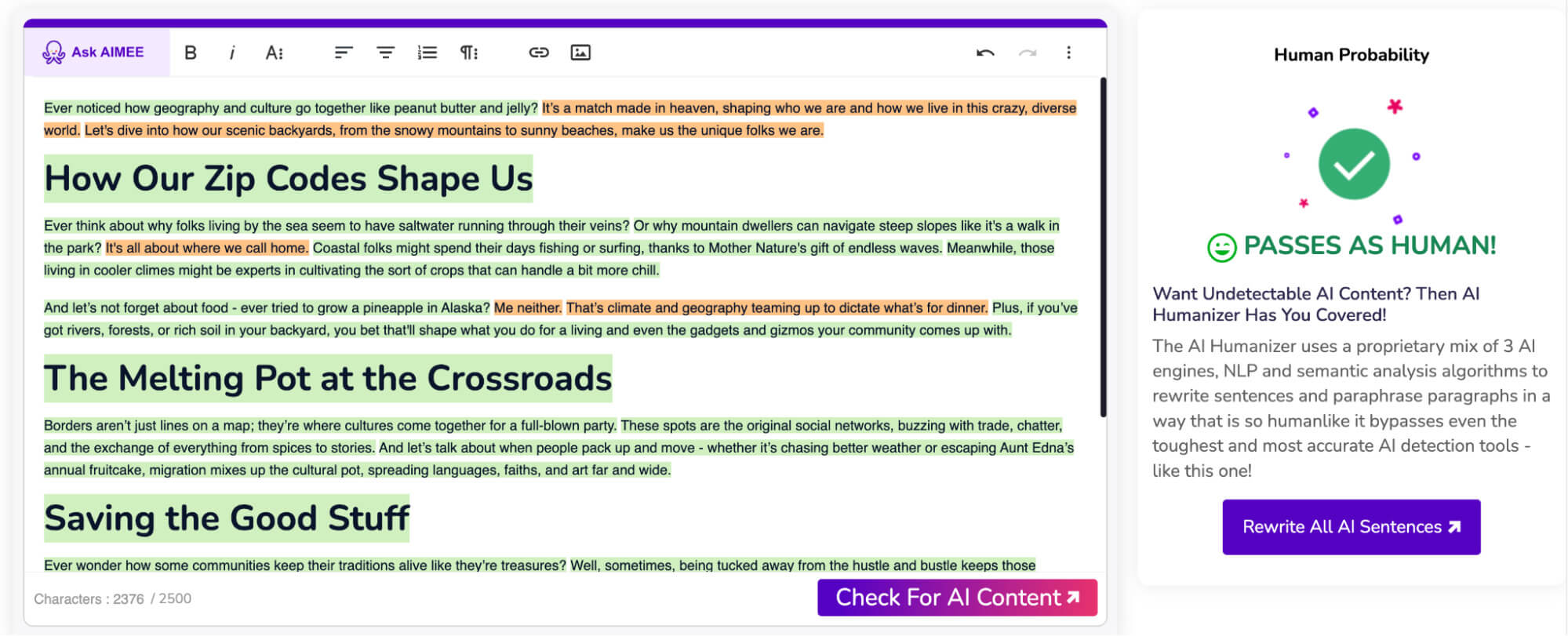
Again, the way we handle the text is working for GPTZero and Content at Scale. The two AI detectors consider the content to be most likely written by humans. Still, this is not working for Originality.ai.
Simplify the Writing
It’s not uncommon for AI content writing tools to use long and complex sentences that truly sound robotic. In other words, keeping things simple is an excellent way to dodge AI detectors. So, break up unnecessarily long sentences into smaller chunks, replace overtly technical words, and simplify confusing wording.
In our revision, we want to ensure the writing feels more accessible and human. For instance, replacing phrases like "profound and intricate relationship" with "deeply connected" simplifies the language without losing meaning. Similarly, breaking down complex explanations into relatable examples, such as the impact of geography on food and jobs, helps avoid the artificial tone often detected in AI-produced content.
This is the result of our modifications:

Let’s put the content against the listed AI detectors:
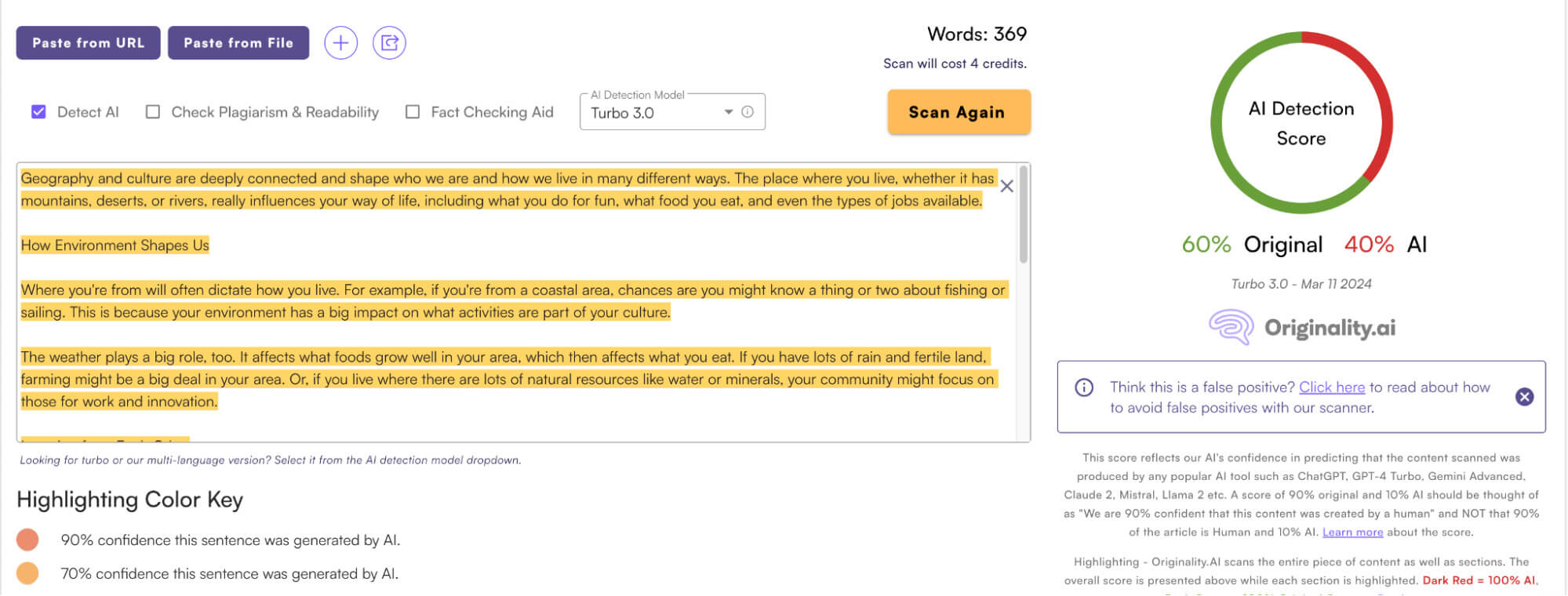
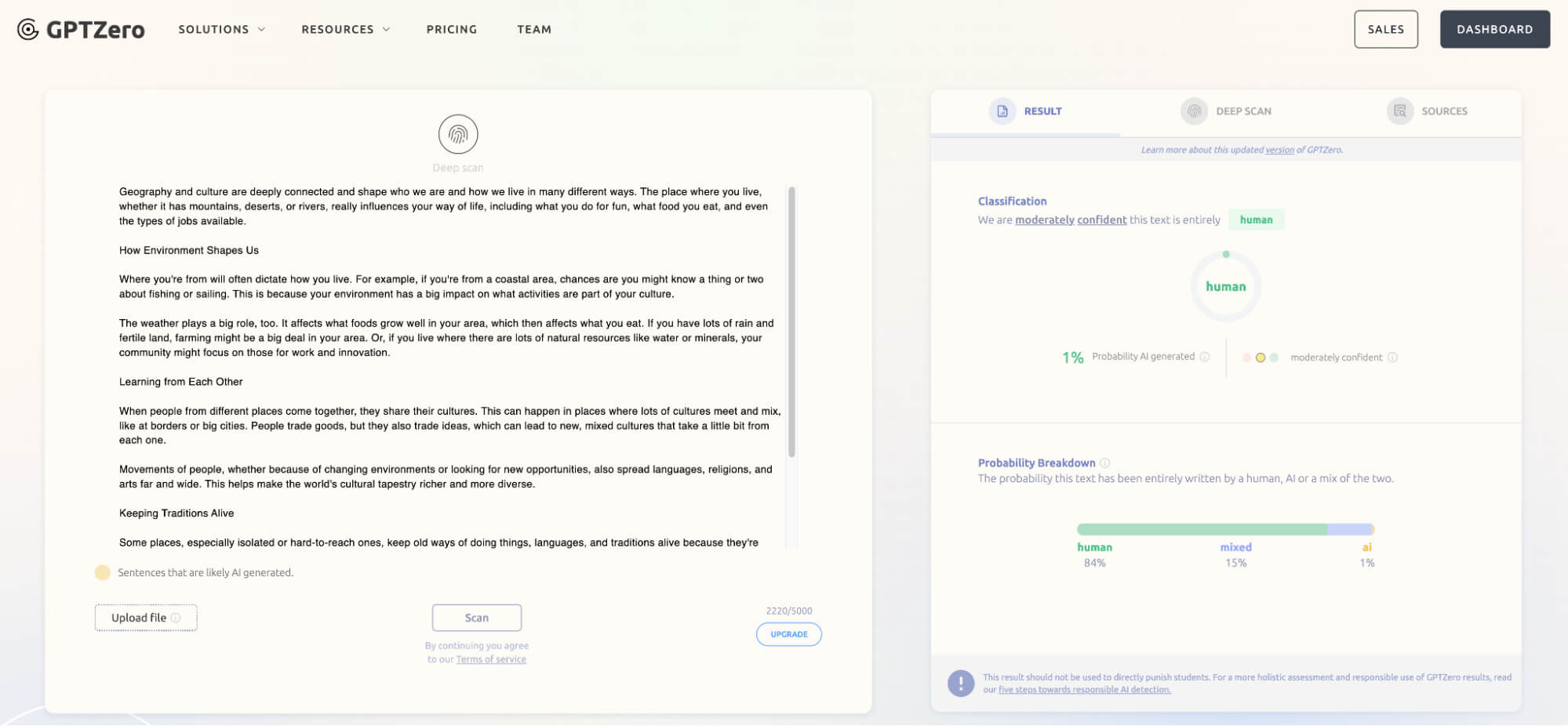
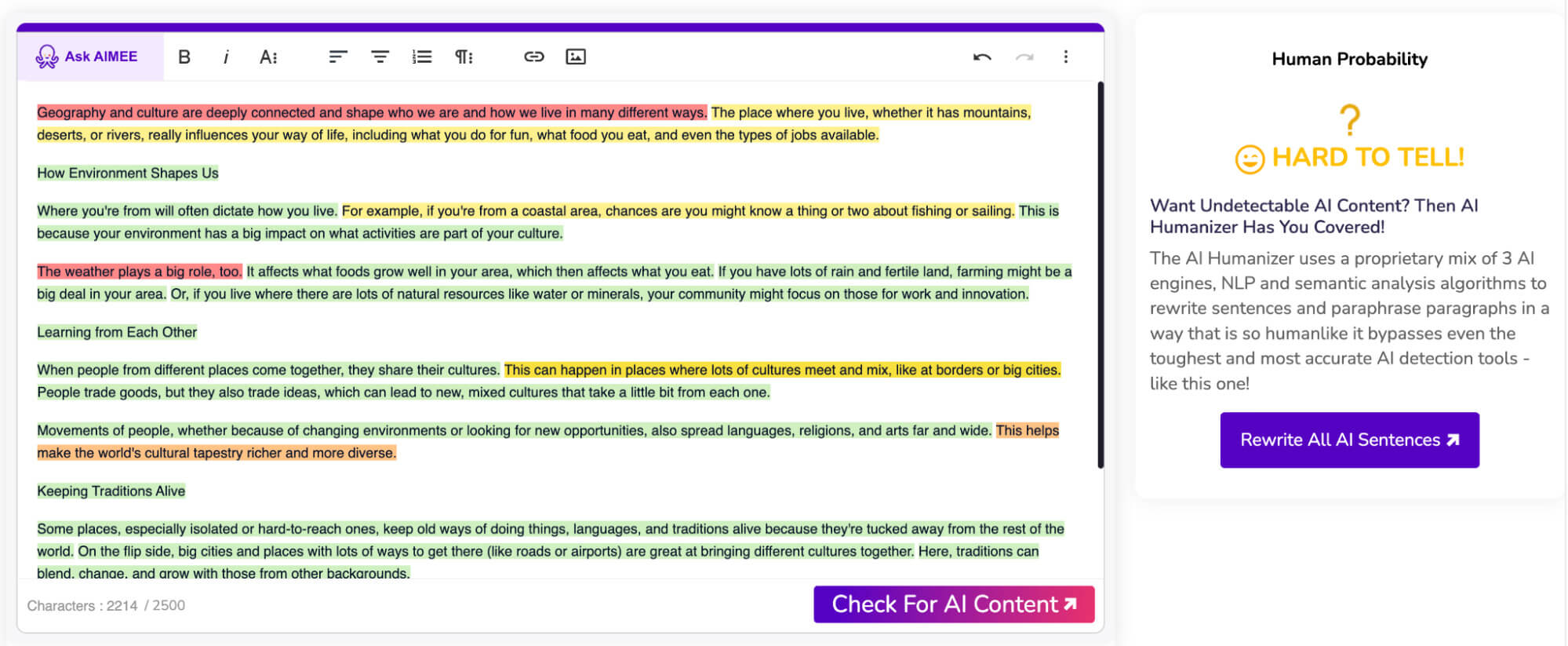
By using this simplification method, we are getting mixed results. Originality.ai considers the content as 60% human, GPTZero considers the content as 84% human-written, and we are getting a hard-to-tell result from Content at Scale.
Thus, while simplifying your AI text may yield varying results across different AI detectors, the approach does seem to have some effectiveness. Moreover, the practice of simplifying content is always good for making complex ideas more accessible and improving the overall readability of any text content.
Use an Active Voice
Another reason why AI writing might seem robotic is the overuse of the passive voice. By switching to active voice, you can make your content less detectable for AI checkers. Plus, you’ll dramatically boost the readability and engagement of your content, which is a huge plus for its readers.
We have made several changes to use more active voices during our article. For instance, instead of saying "traditions and customs from neighboring societies are often witnessed blending," we now actively state "border areas often blend traditions and customs from neighboring societies."
This is the final look of the revision.
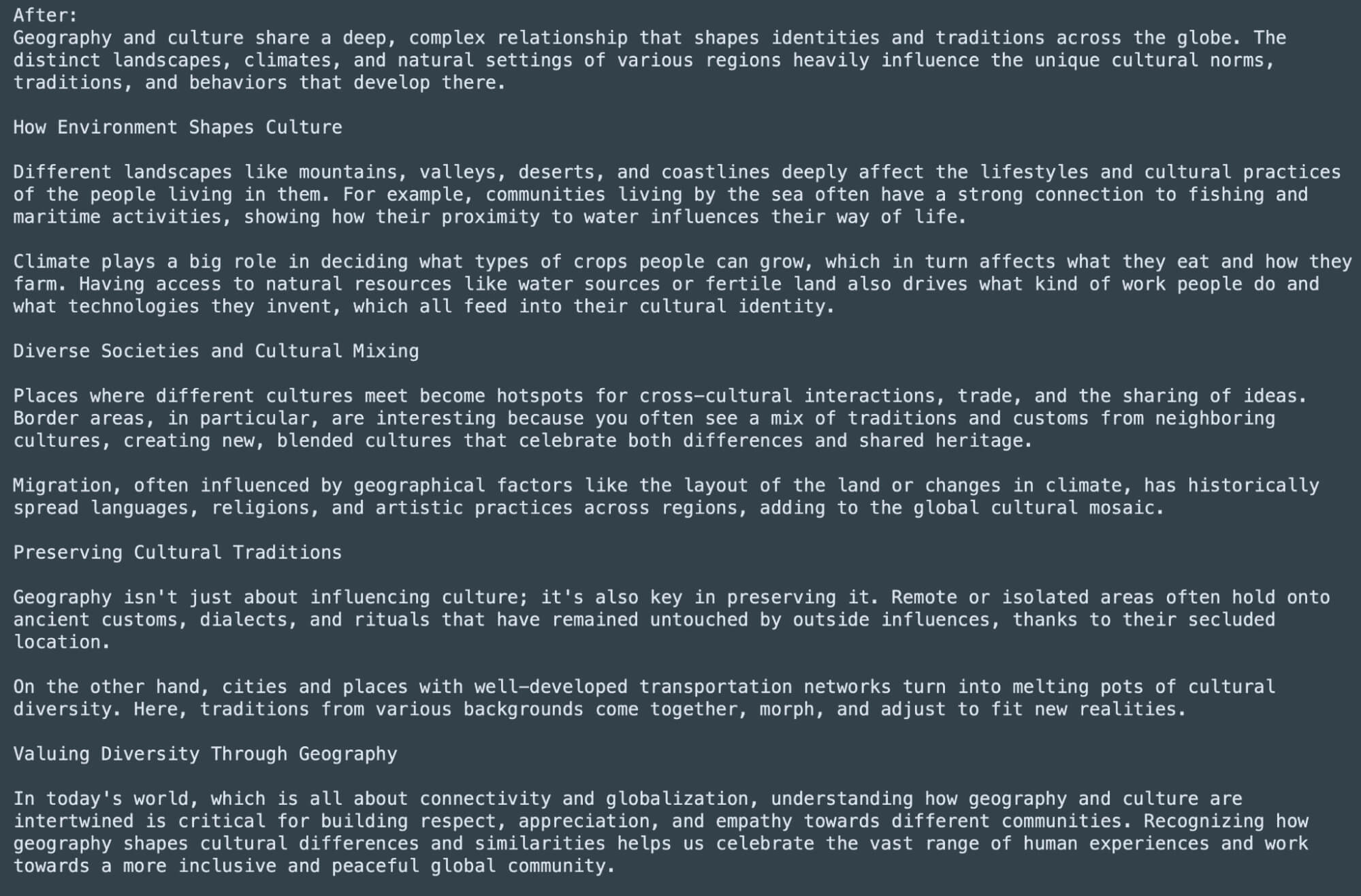
Will this work? Let’s find out.

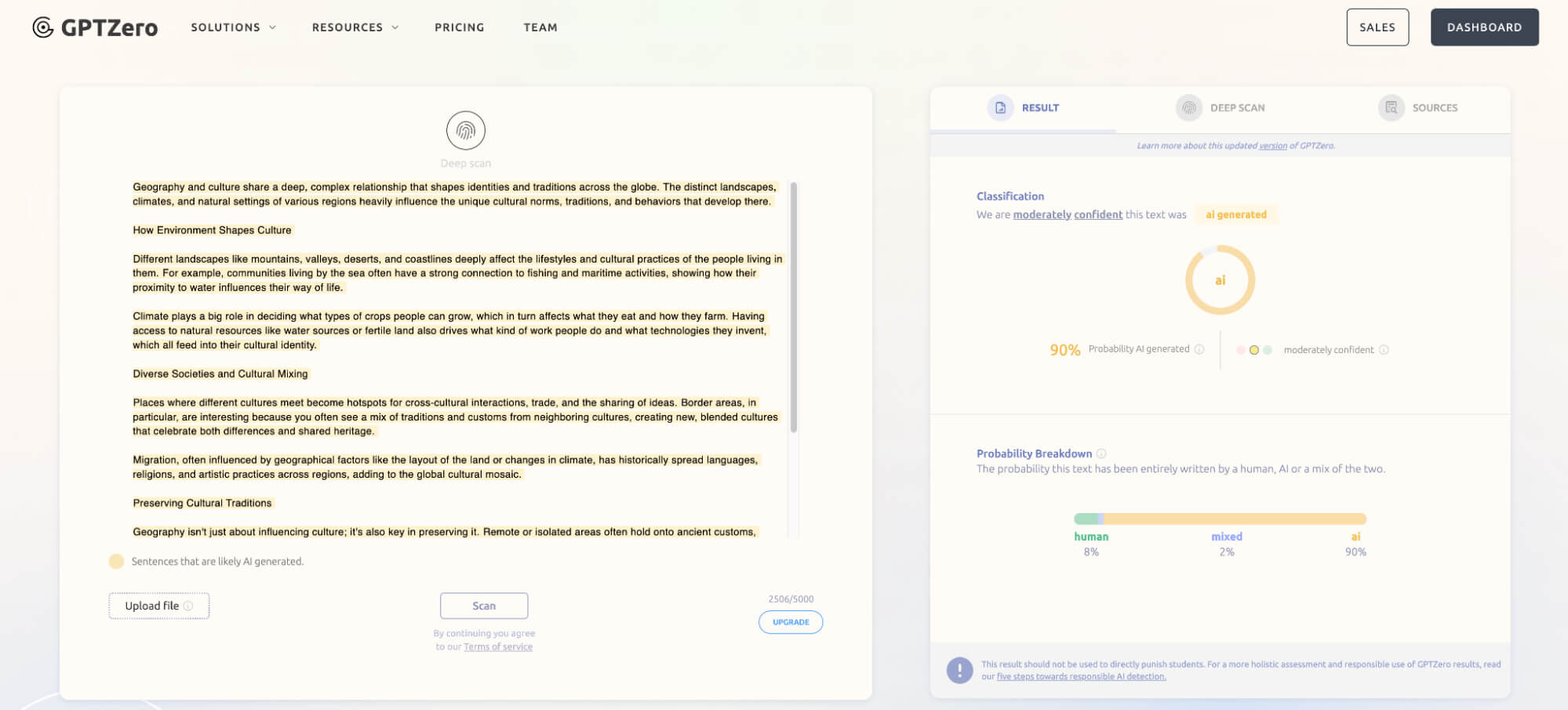
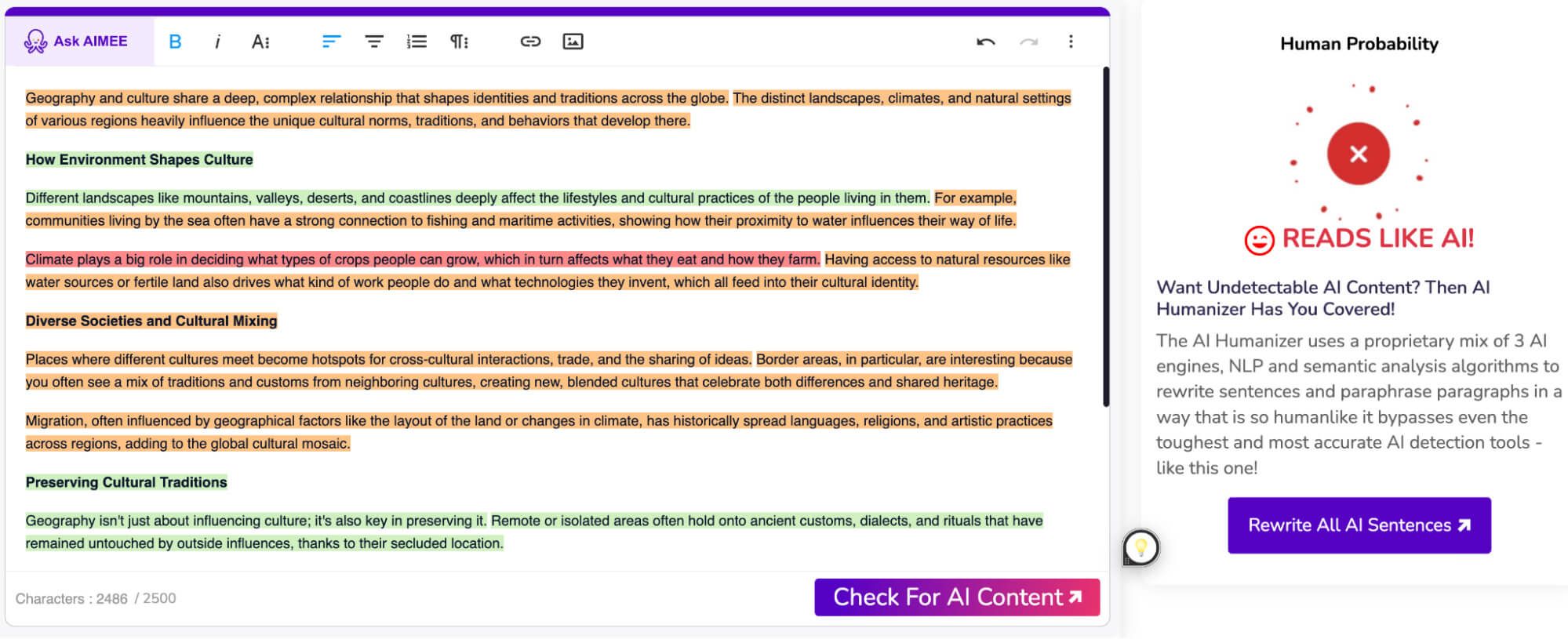
Seems like the tricks are not working. All three AI detectors indicate that the processed content is AI-generated, meaning that simple active voice change is a good idea for writing articles, but not good enough to fully transfer AI-generated content into human-written pieces.
Add Unexpected Twists
Most AI-crafted articles read the same. There’s nothing unique or unpredictable about their flow. That’s where you come in. If your AI-produced article seems a little stale, spruce it up with some unexpected twists, from unconventional conclusions to surprising facts sprinkled throughout the article. This should distinguish your content from the standard AI-generated one.
We are now trying to add some refreshing unpredictability, such as the deep dive into how extreme climates inspire culinary innovations, and the surprising linguistic diversity of coastal communities. These changes can enrich the content, and underscore the relationship between geography and culture, making for a more captivating and engaging narrative.
Here is the revised version of the article:
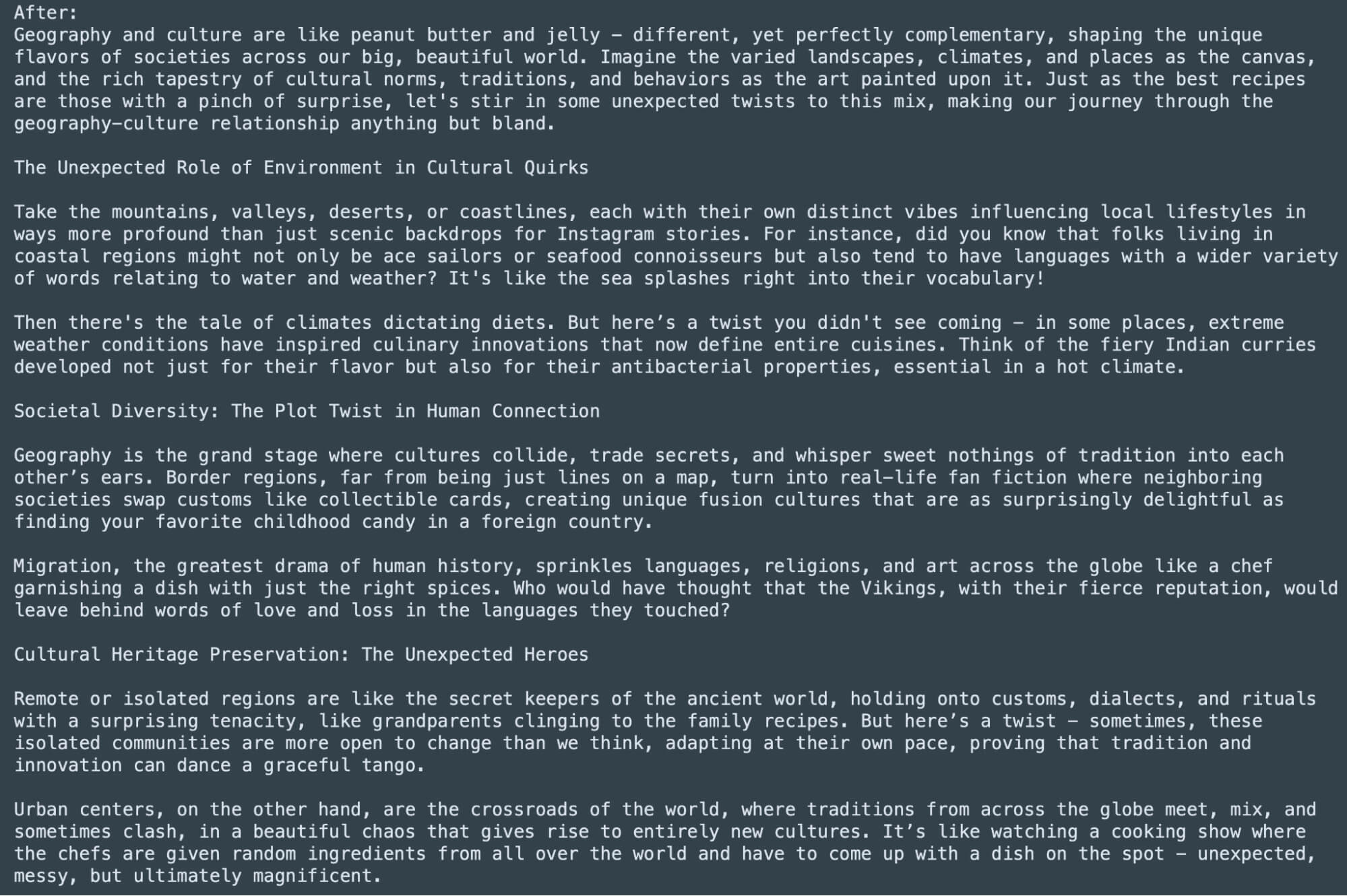
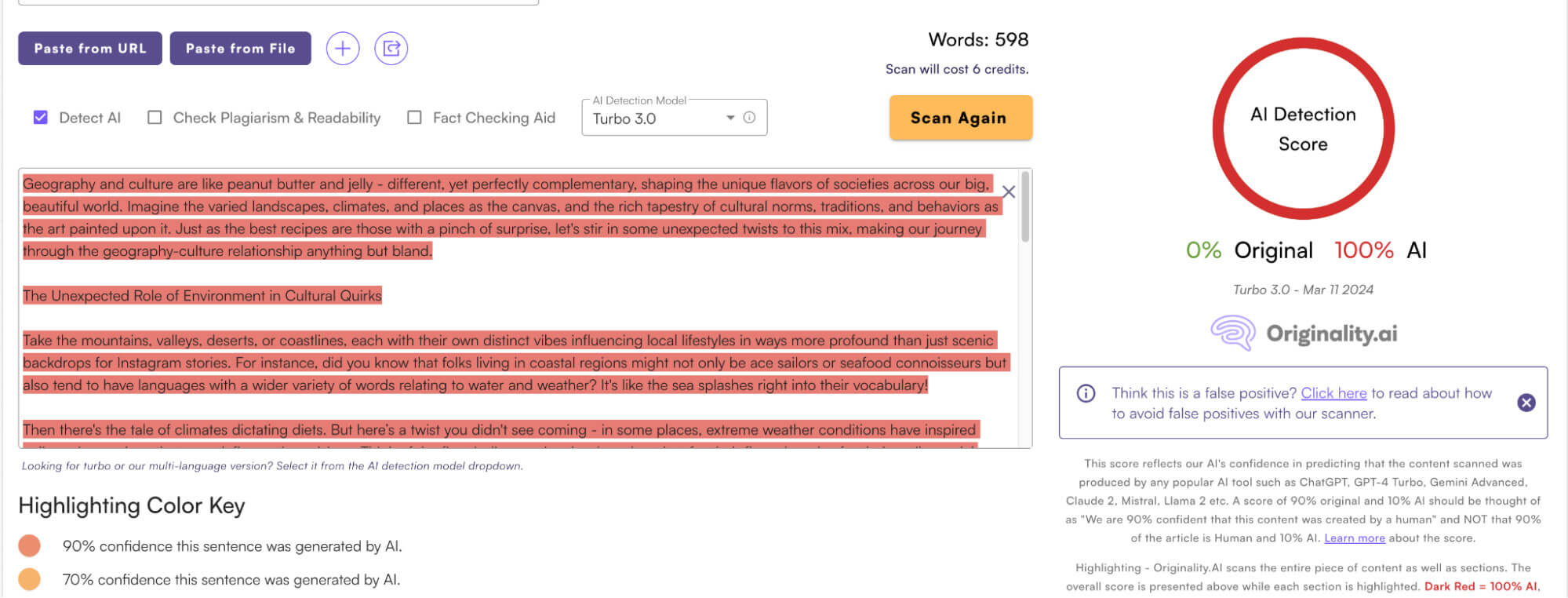
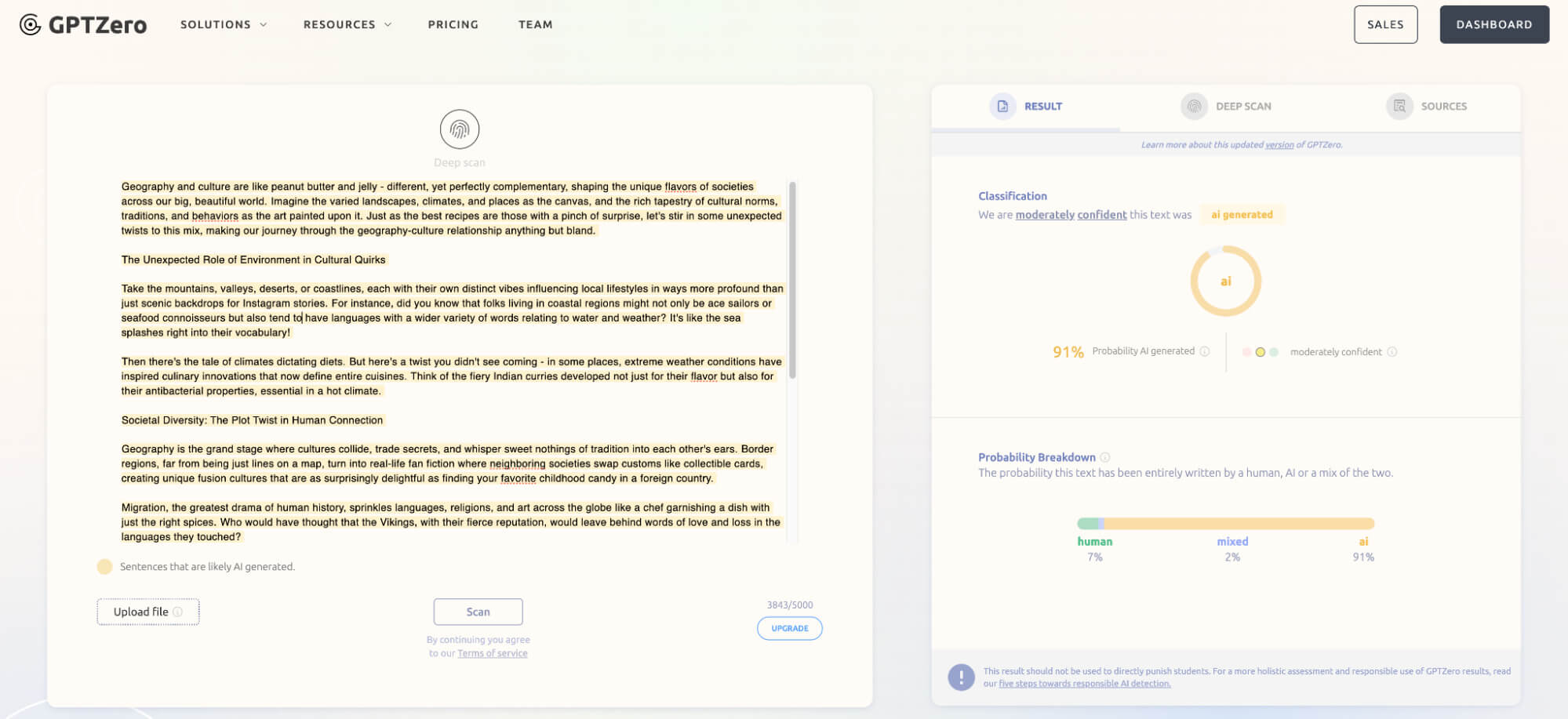
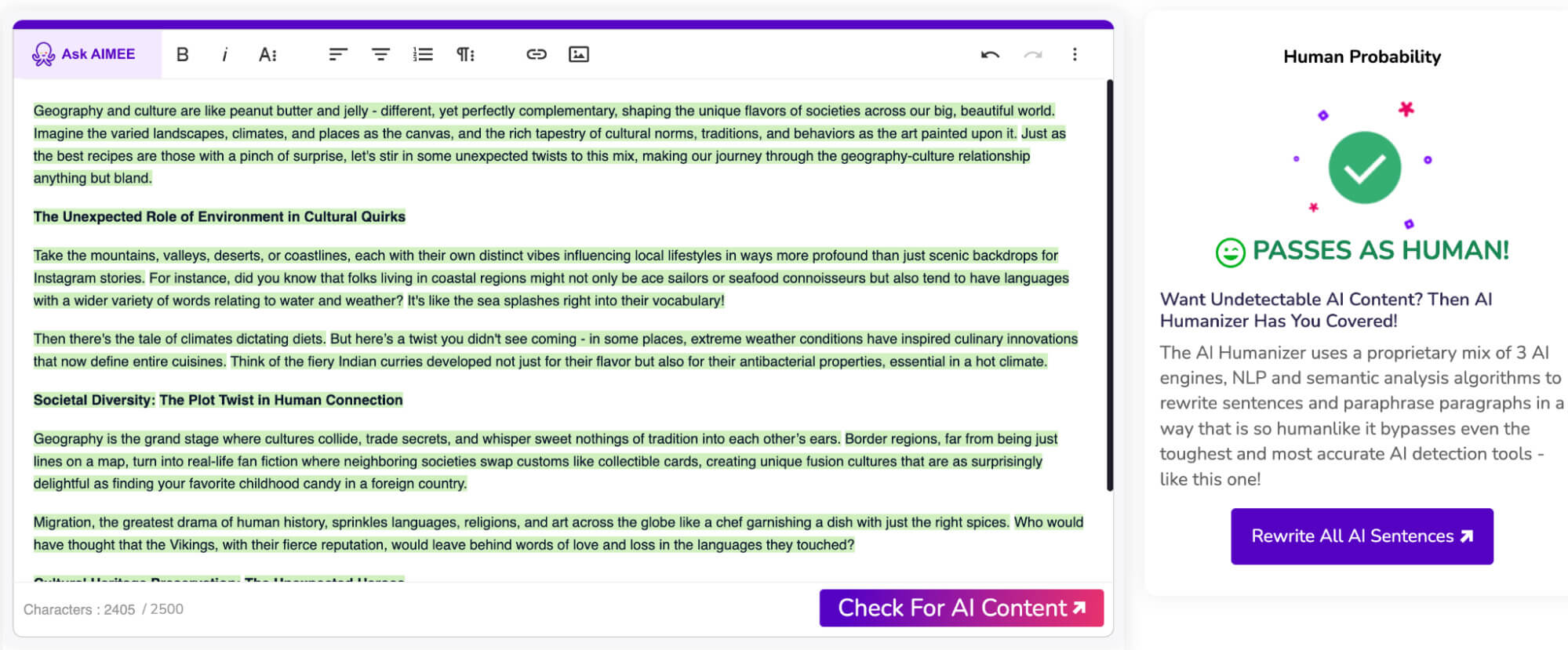
From the results we are getting, this approach is working for Content at Scale, and the content is getting a full human pass from the detector. However, for the rest of the 2 detectors, the content is still flagged as AI-generated.
Why Bypass AI Detection?
As you’ll soon see, bypassing AI detection manually is no easy task. In some instances, it might even take less time to completely rewrite the AI-generated piece than tweak it to avoid an open AI detector. So, why do it? Keep reading, and you’ll immediately get the answer to this question.
Keep Your Content Visible (SEO)
For those content creators out there using AI to assist their content creation process, the first thing to consider is the SEO punishment towards AI-generated content.
Users on social media have already reported that Google is taking serious action to prevent the use of purely SEO-focused AI-generated low-quality content manipulating the SERP rankings. There are numerous cases where website owners reported a significant drop in web traffic after updating their websites with AI-written content.
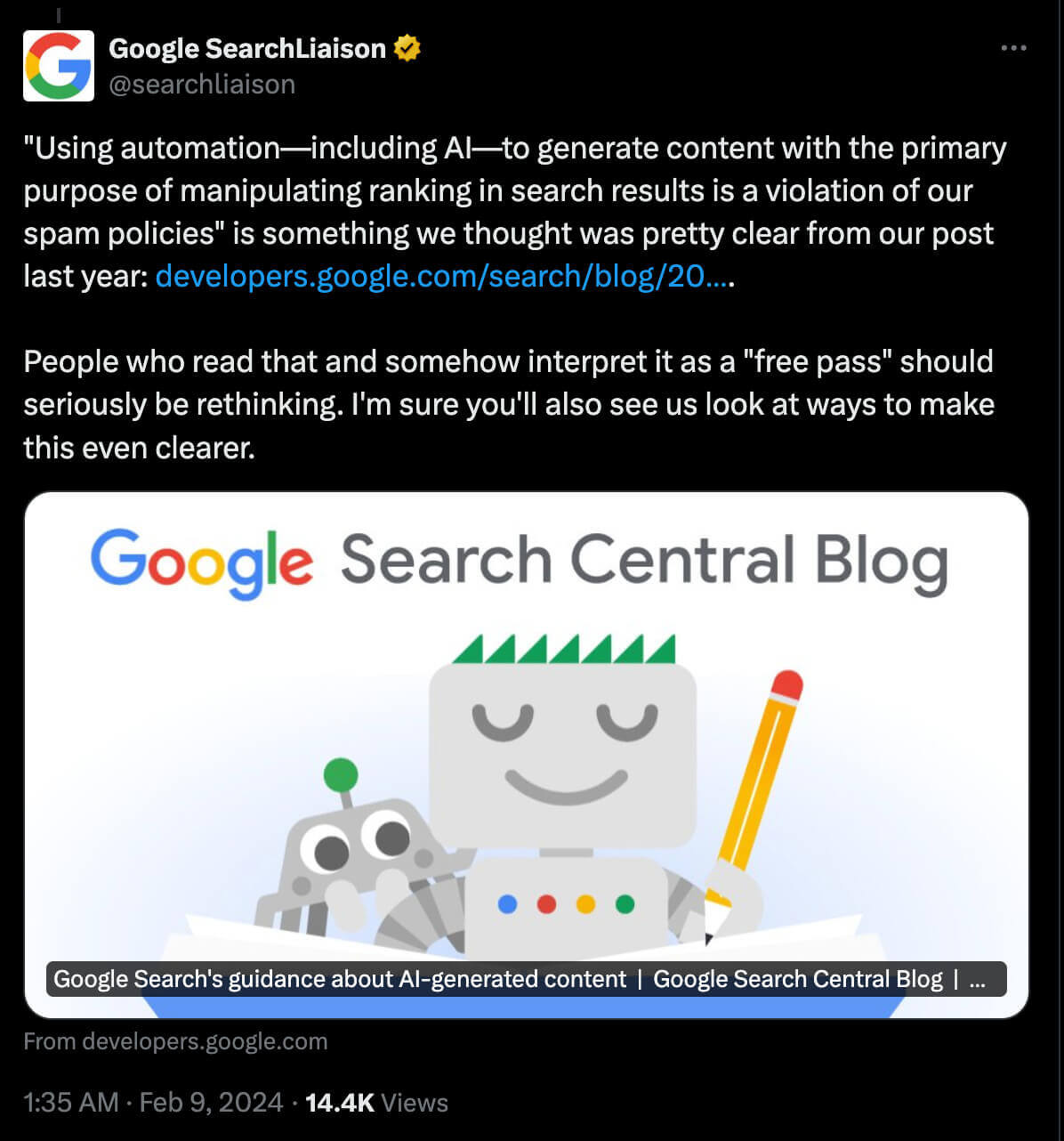
The fact is, according to the official explanation regarding Google’s treatment of AI-generated content, Google will not do anything to useful and informative content, no matter how the content was generated.
However, this is not the core of the AI content issue. Google knows how you generated your content, as well as the purpose, and it seems like it doesn’t care that much about AI involvement in content generation that much. So, what about readers?
Throughout the years, Google has invested a considerable amount of effort in user behavior monitoring, and Google knows if the reader actually likes your content, which is the core of the SEO punishment issue. If your content did pass through the Google algorithm, but readers consider it useless and not human-like, there is a chance that Google is still going to apply the punishment to your content.
Thus, not only do you have to make your content useful to search engines, but the primary goal is that you also have your content related to your readers, whether you are using AI for content writing assistance or complete AI content generation.
In addition to preparing your content in an informative and practical direction, consider transferring your content into a more human-like look. The more human your content sounds, readers are more likely to spend time on your content, as a result, the less likely you are to encounter ranking fluctuations and potential search engine optimization (SEO) issues.
Content Scrutiny & Quality
Numerous internet platforms have integrated AI checkers to scan for traces of AI within their content. The same goes for content-writing agencies and educational organizations that want to ensure their writers and students only turn in original and authentic human-created content.
Well, you are probably thinking about rewriting your AI-generated content and rebuilding the whole content structure in order to outsmart the AI detectors. Sadly, this method may not work for now. There are multiple reports on ChatGPT adding watermarks in the generated content, making those AI detectors easier to spot AI content and harder for users to completely remove the “AI signs” hidden within the text.
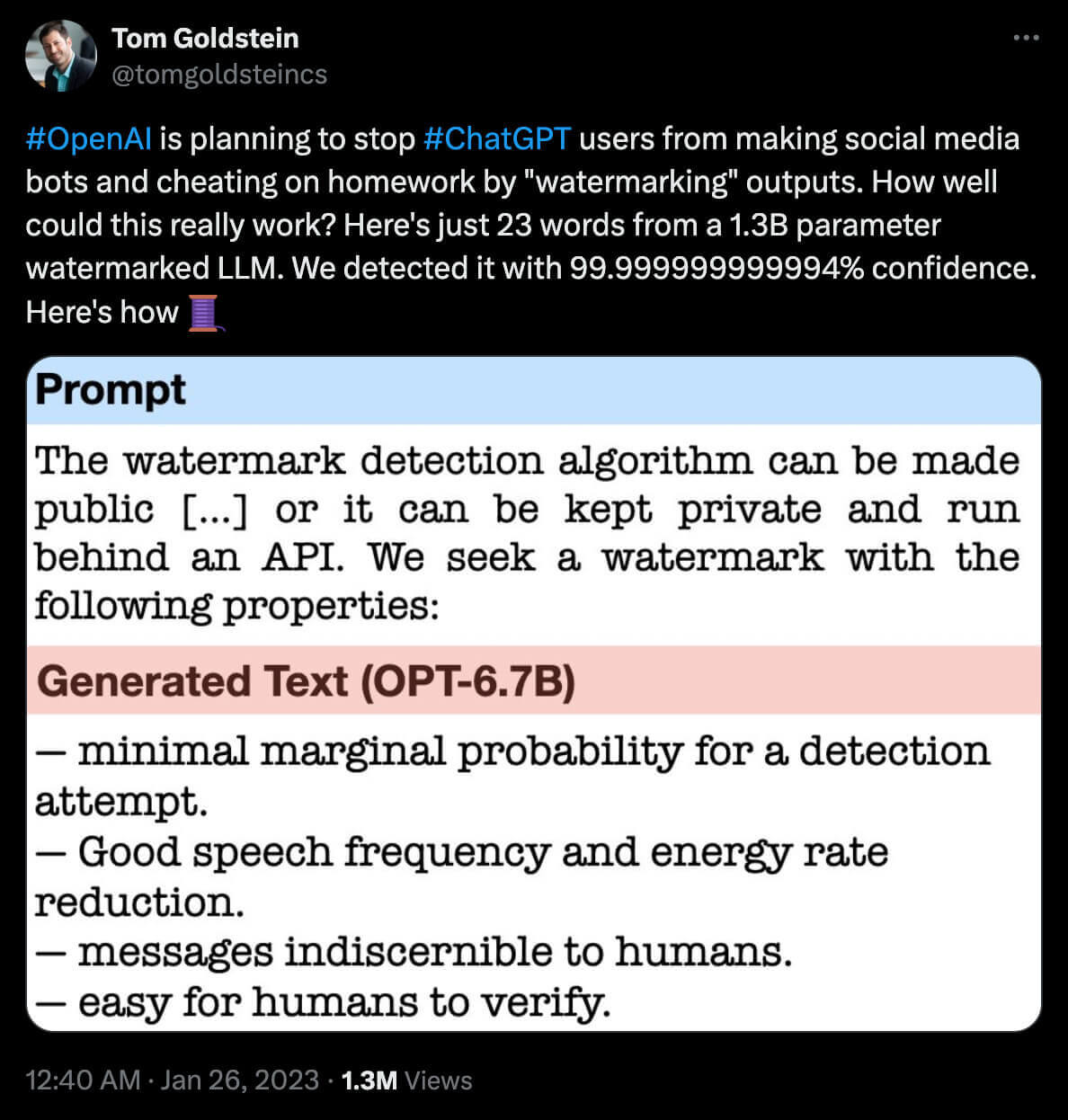
Hence, there is also the possibility of false positives from these so-called “accurate” AI detectors, mistakenly marking fully human-written content as AI-generated, making the situation for content creators even worse. Some known complaints regarding the accuracy issues of Originality.ai, as well as the false flags by GPTZero, are clear signs that speak for themselves.
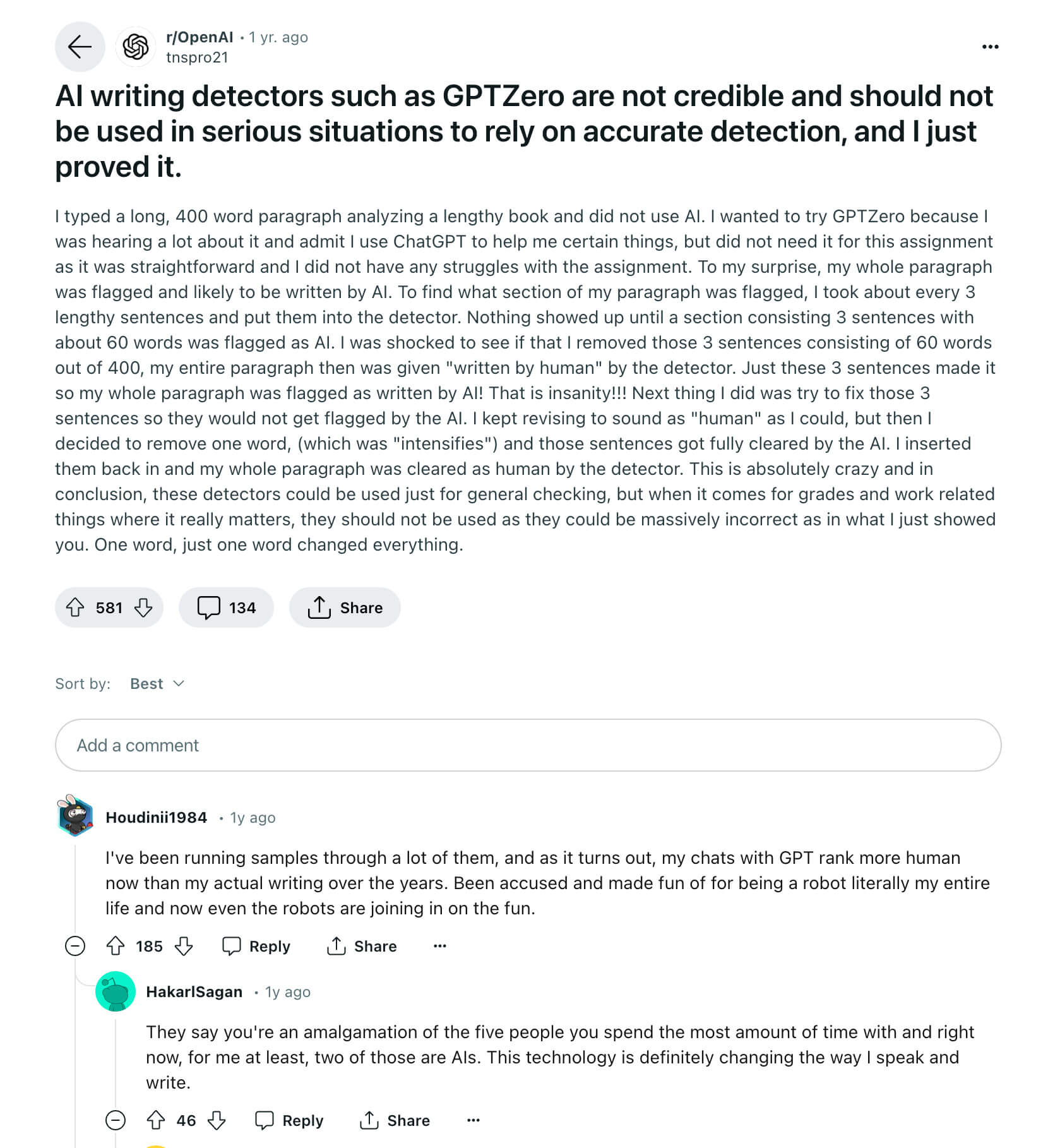
Source: https://www.reddit.com/r/OpenAI/comments/12oj9co/ai_writing_detectors_such_as_gptzero_are_not/
And there is more:

Source: https://www.reddit.com/r/ChatGPT/comments/126g3or/how_does_gptzero_work_it_just_flagged_my_entire/
Thus, it’s become more and more important for students, educators, and content creators to learn how to make AI-generated text undetectable by these AI detectors, in order to safeguard the integrity of your content and avoid potential consequences that come with using AI in your writing process.
Produce Quality Content in Bulk
It’s undeniable that an AI-writing tool can create content at a much faster rate and in larger volumes than human writers. Sure, if you want to create content at scale, AI detector tools will stand in your way. But given how beneficial AI-writing tools can be, the potential hassle with AI detection bypass is well worth it. Even if you spend some time nailing how to get around AI detector tools, you’ll still save time and resources in the long run.
“AI-Proof” Your Content With HIX Bypass
Given AI’s impressive potential in content creation, avoiding detection has become a vital skill for content creators. This guide has shown you how to bypass AI detection manually, thus increasing the chances of evading AI detection. However, the manual approach might not be the best for ambitious content creators in terms of efficiency and content quality.
If you want to humanize your content as fast as you produce it, and in a qualitative fashion, an AI humanizer like HIX Bypass is the best way to go. With HIX Bypass, your content will have the human-like charm that easily tricks AI detectors with minimal input on your part. Try HIX Bypass today for free and AI-proof your content in no time.
